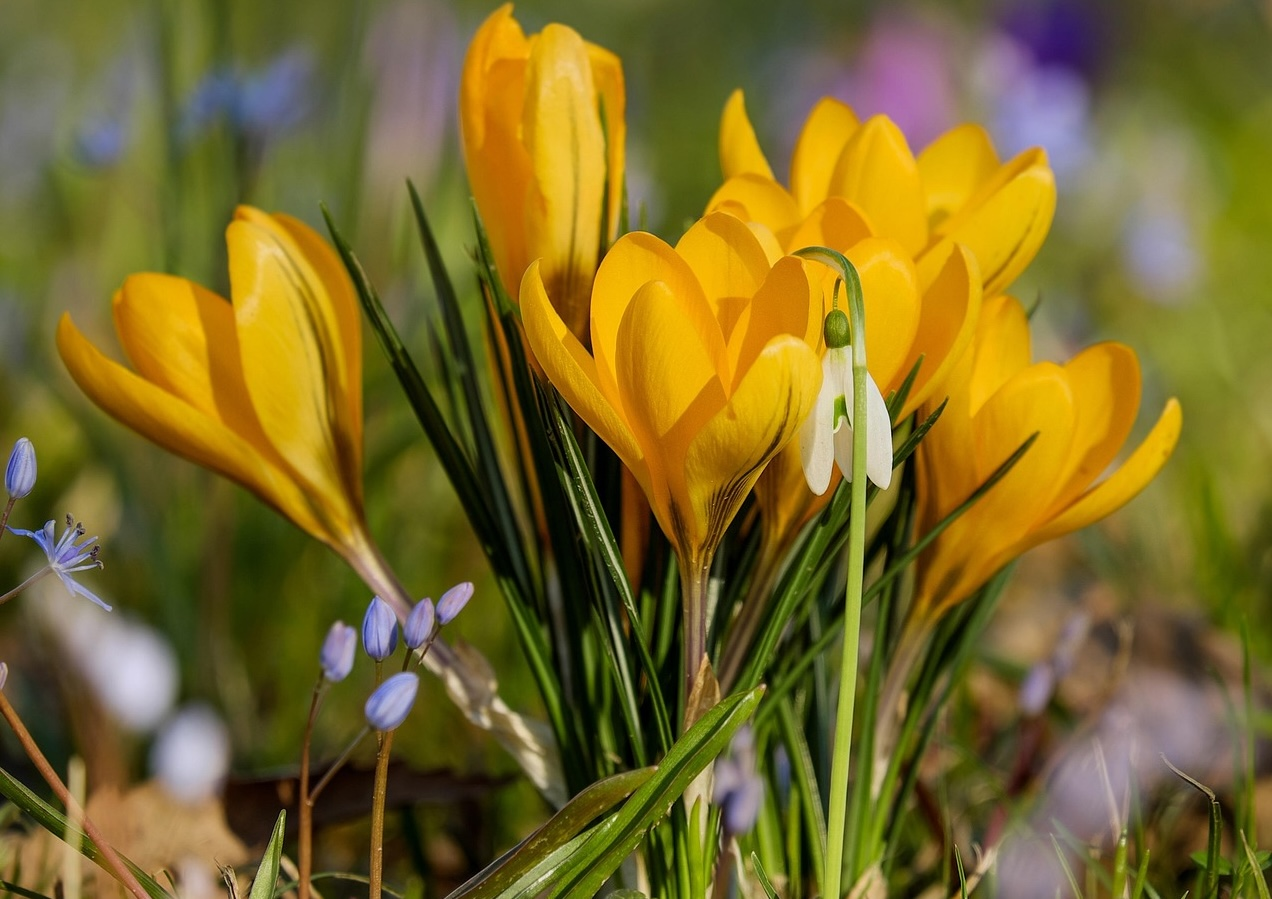
Early Bloomers: Spring Flowers in the Garden
This article is about early bloomers, the first plants to flower in spring. Here you will find a list of common early bloomers with pictures so that you can recognize them on your next walk or perhaps even in your garden. We also explain their benefits and what they have to do with the phenological seasons and climate change.
This Article Contains:
- Early Bloomers: Valuable Plants in Spring
- Early Bloomers as Markers for Climate Change: Phenological Changes
- A List of Common Early Bloomers With Pictures: What Early Bloomers Are There?
- Spring Bloomers From February: The Early Birds
- Early Bloomers in March: Harbingers of Spring
- Spring Is Here: Spring Flowers From April
- Frequently Asked Questions About Early Bloomers
Quick Overview
Common Spring Bloomers in Europe: A List
- Flowering from February: winter aconite (Eranthis hyemalis), squills (Scilla), snowdrops (Galanthus), coltsfoot (Tussilago farfara), cornelian cherry (Cornus mas), daisies (Bellis perennis), crocus (Crocus),...
- Flowering from March: willow (Salix caprea), lungwort (Pulmonaria), violet (Viola), forsythia (Forsythia), primrose (Primula), liverwort (Hepatica), wood anemone (Anemone nemorosa),...
- Flowering from April: grape hyacinth (Muscari), tulip (Tulipa), wild garlic (Allium ursinum), blackthorn (Prunus spinosa), dandelion (Taraxacum), lesser celandine (Ficaria verna)
Early Bloomers: Valuable Plants in Spring
Early bloomers are the first plants to start flowering in the year. These plants start to form flowers in February. This provides the first food of the year for insects such as bees and bumblebees. For this reason, these plants are usually valuable for wildlife, which is why it is good to be familiar with these plants as a gardener. You can also use some of these plants for yourself, as a few are also edible and/or can be used as medicinal plants. So if you find one or two of these plants in your garden, you can see them with different eyes. You can also leave most of the early bloomers to grow, because by the time most of the vegetable plants are planted, these herbs will have retreated again. It is also important to note that most of the herbs mentioned here are native to Europe.
Early Bloomers as Markers for Climate Change: Phenological Changes
As already mentioned, early bloomers are a sign of the start of spring in regions with temperate latitudes. This means that early bloomers are so-called biomarkers by which you can recognize how far nature has developed (The Umweltbundesamt, 2024). These biomarkers, such as the flowering time of certain plants, are also used by researchers. They study the development of plants and animals over the course of the year and use them to define the so-called phenological seasons. These changes and phenological seasons are documented by the German Weather Service (DWD, 2023). But these changes in phenological seasons are being observed worldwide, with variations depending on regional climate and environmental conditions. Overall, it can be said that extreme weather events are expected to increase globally due to rising temperatures caused by climate change (Lang, W. et al, 2024). A lot has changed since climate change and we gardeners are well advised to be aware of these changes in order to make our gardens more resilient.
Changes in the Phenological Seasons in Germany
The vegetation period, i.e. the growing times of the plants, are shifting. This is due to an earlier start to spring in combination with shorter, warmer winters. Temperatures are higher overall, which means that plants sprout and flower more quickly. On average, depending on the plant, it is already 2 to 4 weeks earlier than in the previous period, with an upward trend. Winters are on average around 19 days shorter and with less frost and snow. This phenomenon is being observed throughout Germany, which means that climate change in Germany is resulting in a longer growing season. That sounds pretty good at first. However, climate change is causing temperatures to rise sharply, which increases extreme weather events such as droughts and heavy rainfall.
A List of Common Early Bloomers With Pictures: What Early Bloomers Are There?
Below I will introduce you to some of the most common early bloomers. This list is not exhaustive, but it will give you an initial overview and is a good place to start. In addition to the benefits for your garden, knowing about the plants will also help you to recognize phenological markers of nature. These plants are usually the messengers of spring and indicate how far nature has come in its development. Especially in times of climate change, it is important to know such markers. Further down in the article, we explain the phenological changes caused by climate change.
Spring Bloomers From February: The Early Birds
| Early Bloomer | Flowering Time | Location | Edible |
|---|---|---|---|
| Winter aconite | February - March | partially shaded, moist | no |
| Snowdrops | February - April | partially shaded, moist | no |
| Coltsfoot | February - May | sunny, dry | yes, used as medicinal plant |
| Dogwood | February - April | sunny, calcareous | yes, fruits and flowers are edible |
| Daisy | all year round | sunny | yes, flowers are edible |
| Crocus | February - March | sunny | partially edible (e.g. saffron comes from Crocus sativus) |
| Scilla | February - April | moist, well-drained | no, it is poisonous! |
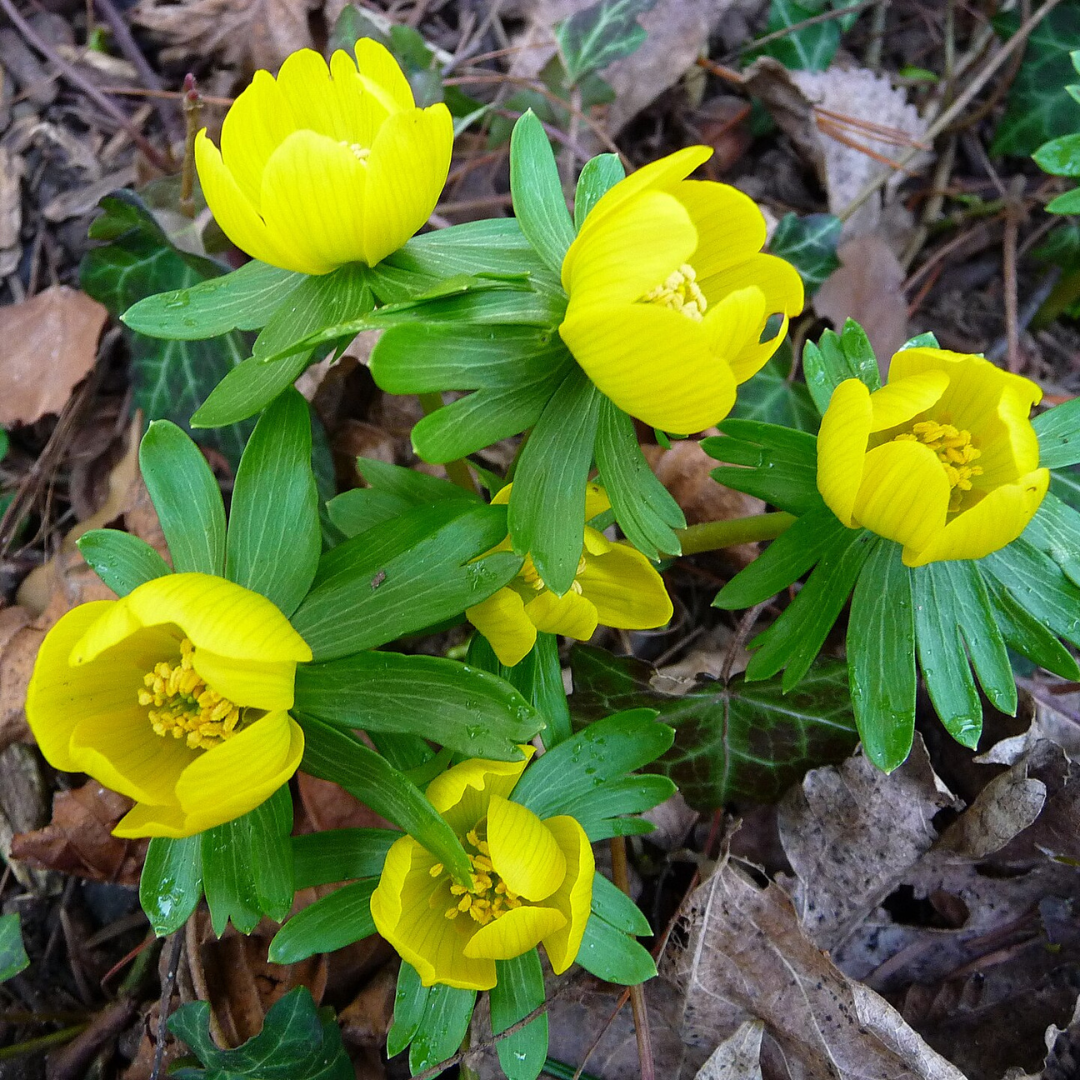
This is what a winter aconite looks like – you’ve probably seen one before! // Image by 3268zauber on WikimediaCommons, CC BY-SA 3.0
Winter Aconite (Eranthis Hyemalis)

This is what a winter aconite looks like – you’ve probably seen one before! // Image by 3268zauber on WikimediaCommons, CC BY-SA 3.0
The winter aconite (Eranthis hyemalis) belongs to the buttercup family, which is also evident in its appearance. It blooms from February to March. The leaves remain visible until summer but then retreat underground until the next early spring. Winter aconites thrive in nutrient-rich, loose loamy soil and prefer a shady spot.
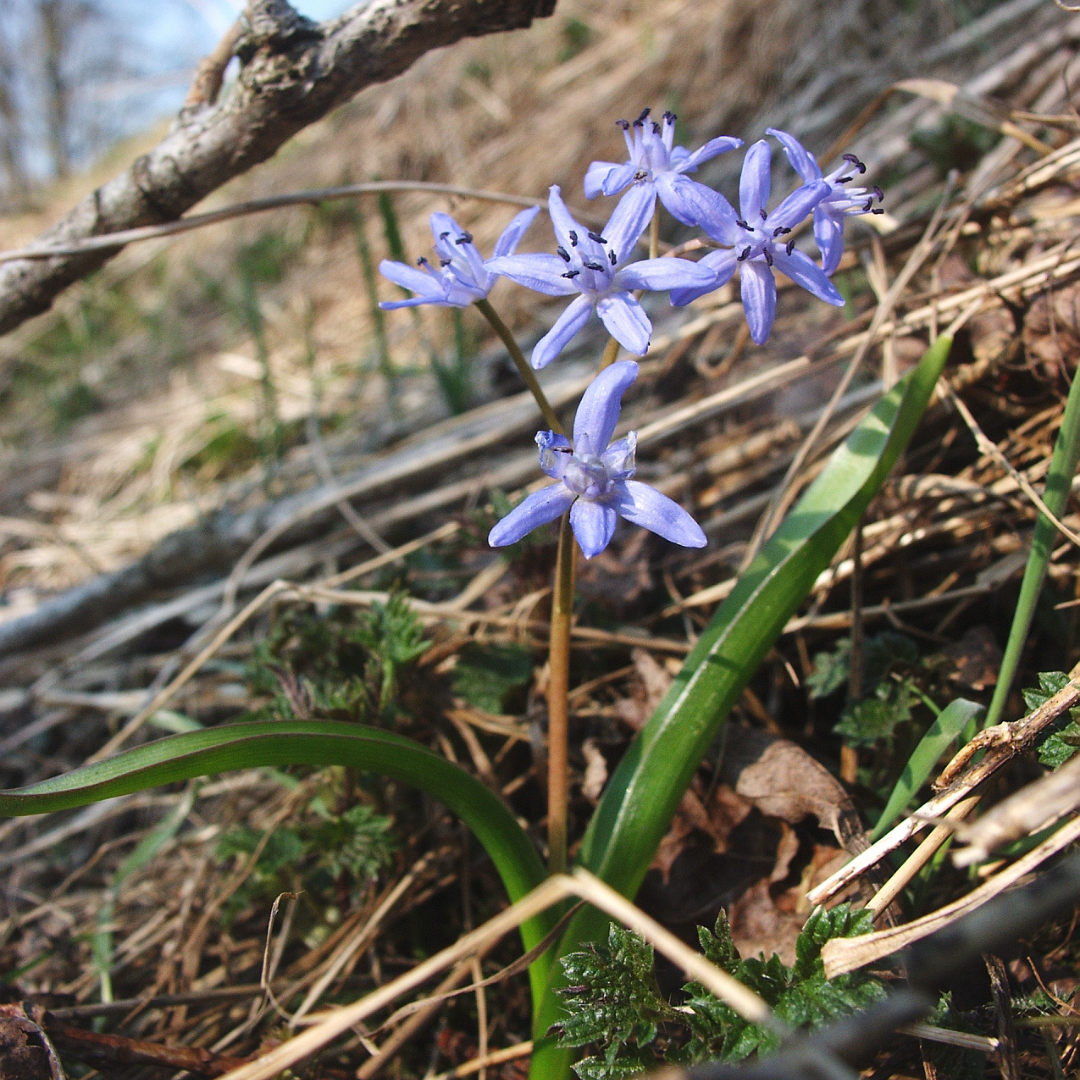
Despite their delicate flowers, squills stand out. // Image by Bernd Haynold on WikimediaCommons, CC BY 2.5
Squills (Scilla L.)

Despite their delicate flowers, squills stand out. // Image by Bernd Haynold on WikimediaCommons, CC BY 2.5
Squills (Scilla L.) belong to the asparagus family. Their beautiful, delicate flowers appear from February to April, usually shortly after the snowdrops. However, there are also species that bloom well into September. Squills are quite hardy plants and adapt to a wide range of locations. The soil just needs to be sufficiently moist and well-drained.
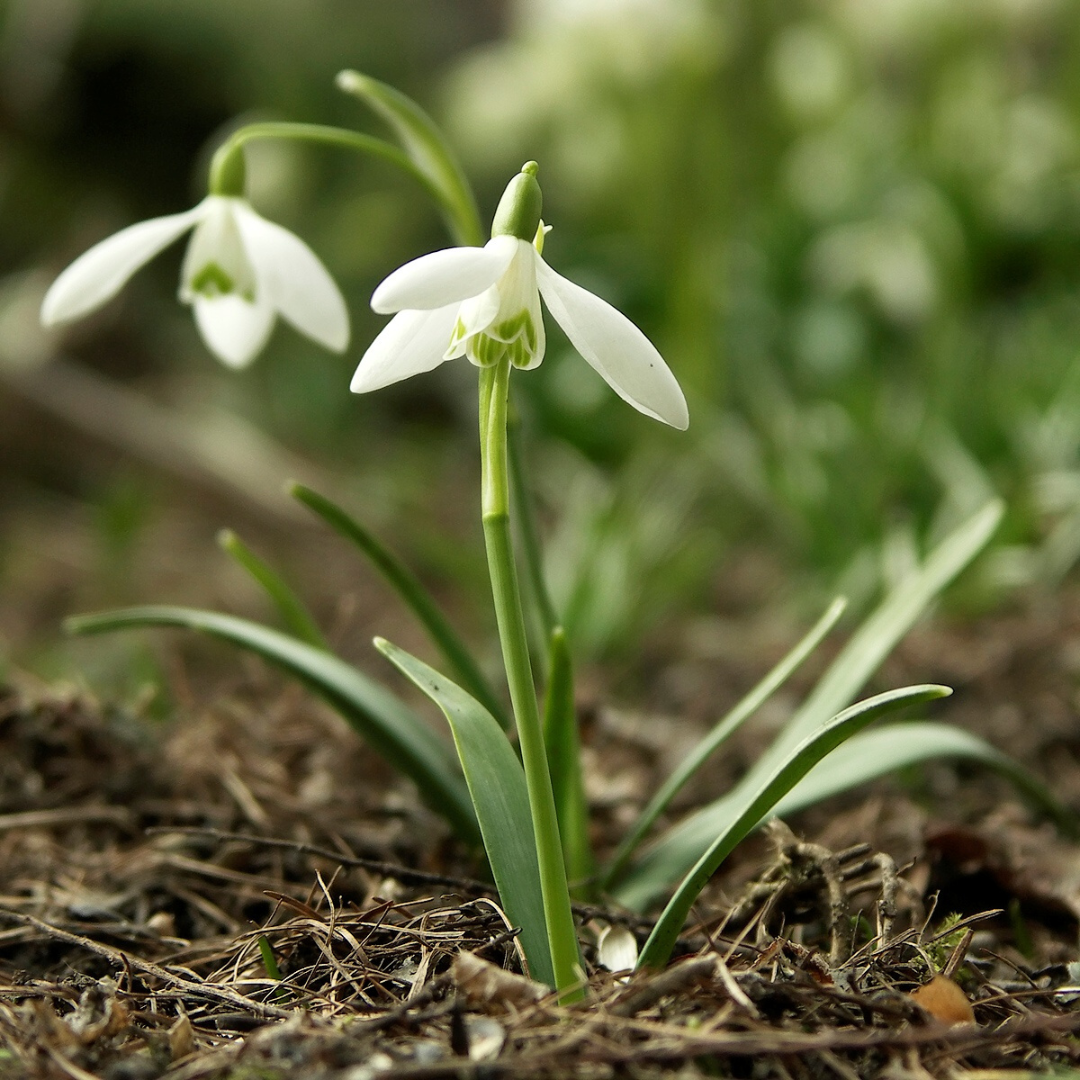
Snowdrops are popular ornamental plants in parks and gardens. // Image by Caroig (David Paloch) on WikimediaCommons, CC BY-SA 3.0
Snowdrops (Galanthus L.)

Snowdrops are popular ornamental plants in parks and gardens. // Image by Caroig (David Paloch) on WikimediaCommons, CC BY-SA 3.0
Snowdrops (Galanthus L.) belong to the amaryllis family and are bulb flowers. In Central Europe, the most common species is the common snowdrop (Galanthus nivalis). It blooms from February to April, and even its flowers are frost-resistant. In the wild, snowdrops usually grow in the semi-shaded undergrowth of deciduous forests with moist, nutrient-rich loamy soil.
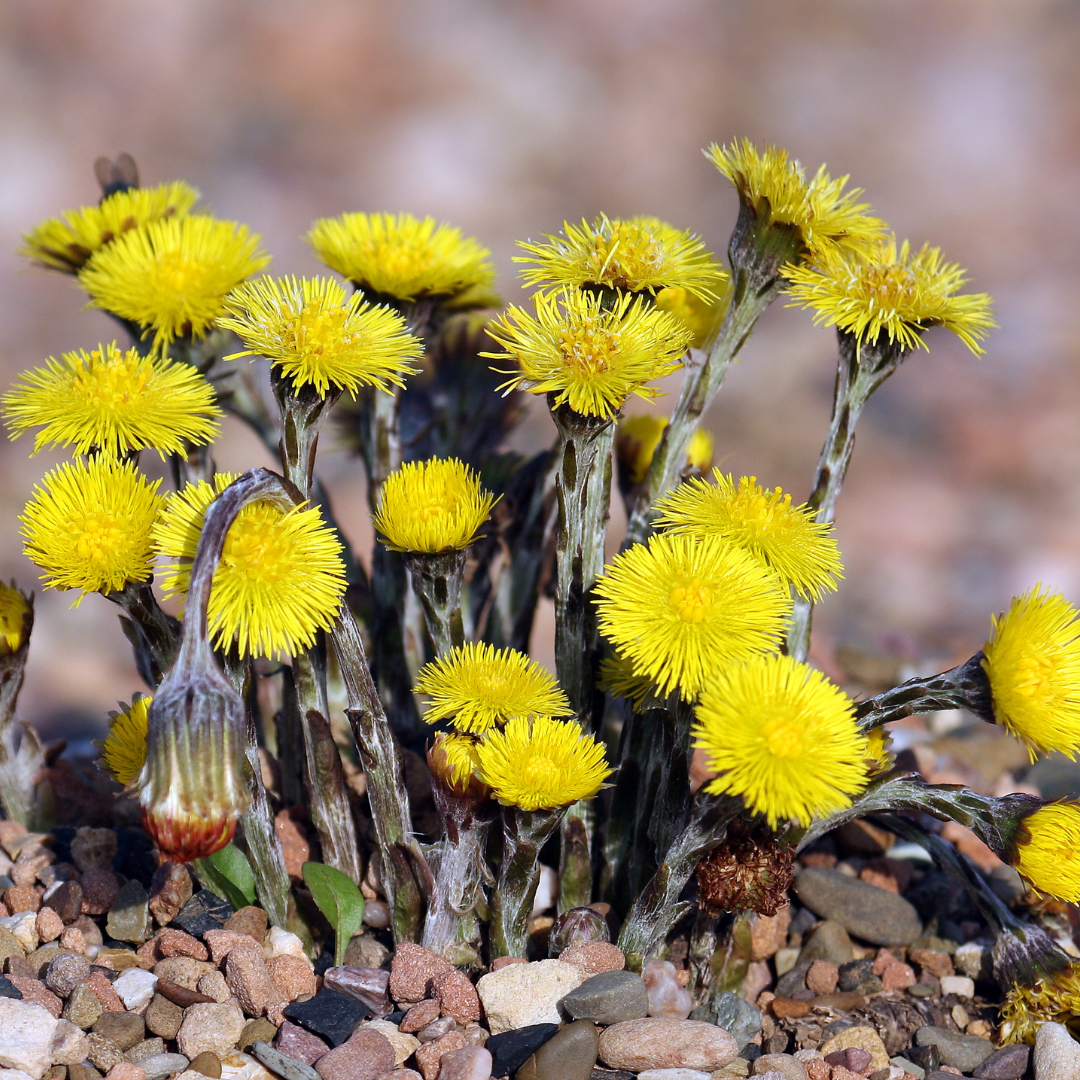
First come the flowers, then the leaves. // Image by Andreas Trepte on WikimediaCommons, CC BY-SA 2.5
Coltsfoot (Tussilago Farfara)

First come the flowers, then the leaves. // Image by Andreas Trepte on WikimediaCommons, CC BY-SA 2.5
The coltsfoot (Tussilago farfara) belongs to the daisy family. Its bright yellow flowers also appear very early in the year, between February and May. It is known by many names, such as cash plant, horsehoof, coltsfoot, or foal’s foot. Coltsfoot is quite hardy and grows in nearly all locations: slopes, paths, riverbanks, quarries, or sand pits. Coltsfoot is a medicinal plant used to treat colds, respiratory diseases, and coughs, and its essential oil is therefore very valuable. Both Hippocrates and Hildegard of Bingen mention coltsfoot in their writings.
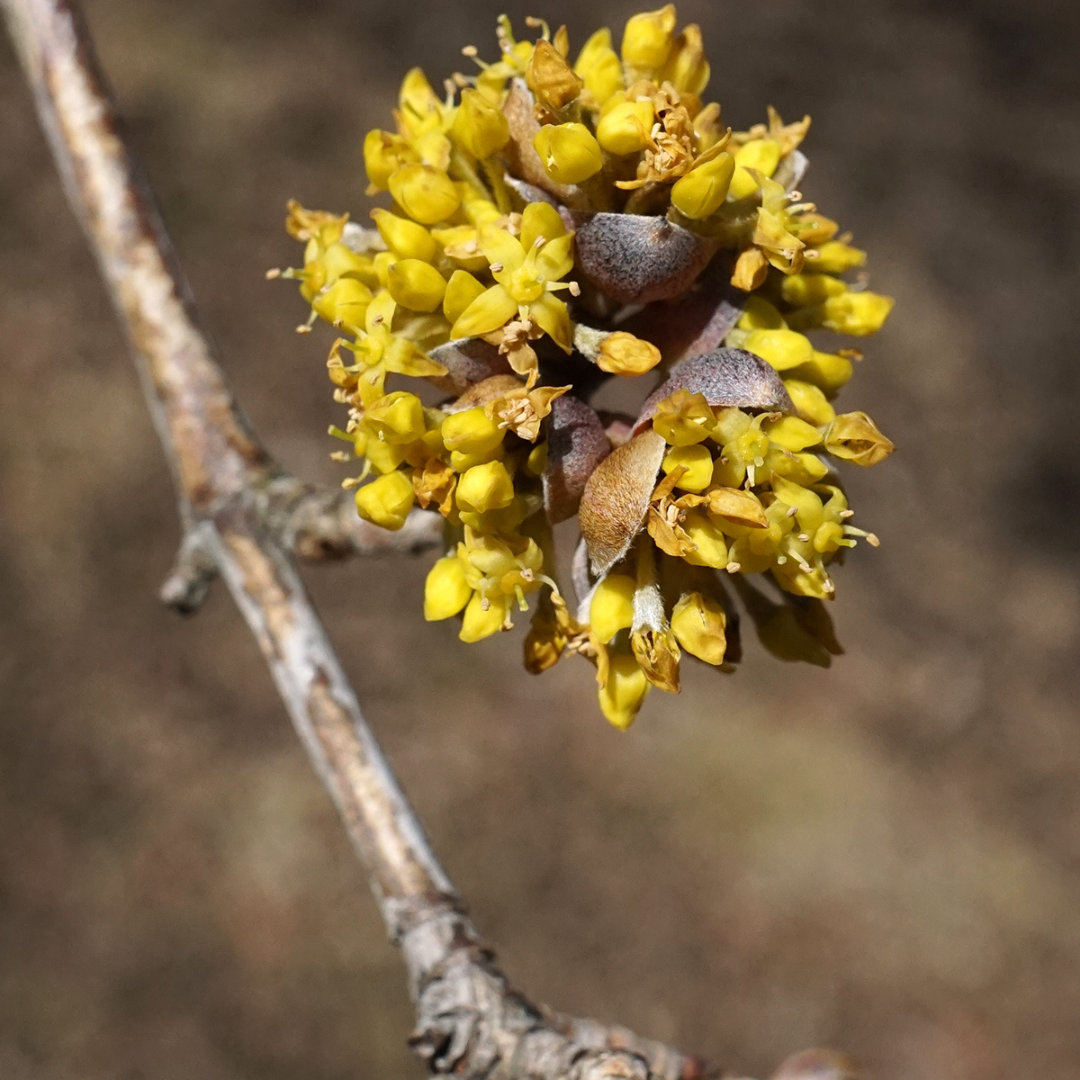
Wild cornelian cherry in bloom. // Image by Uoaei1 on Wikimedia Commons, CC BY-SA 4.0
Cornelian Cherry Dogwood (Cornus Mas)

Wild cornelian cherry in bloom. // Image by Uoaei1 on Wikimedia Commons, CC BY-SA 4.0
The cornelian cherry (Cornus mas) is a native shrub from the dogwood family. Its small, golden-yellow flowers appear between February and April. Cornelian cherries are especially valuable plants for wildlife: their blossoms provide food for insects, and the shrub offers shelter and nourishment for many other wild animals. It thrives in warm conditions and prefers semi-shaded to sunny slopes, open woodlands, or hedgerows. It’s not very picky about its location. In the wild, you’ll often see it growing alongside hazel, ivy, goat willow, or wild roses.
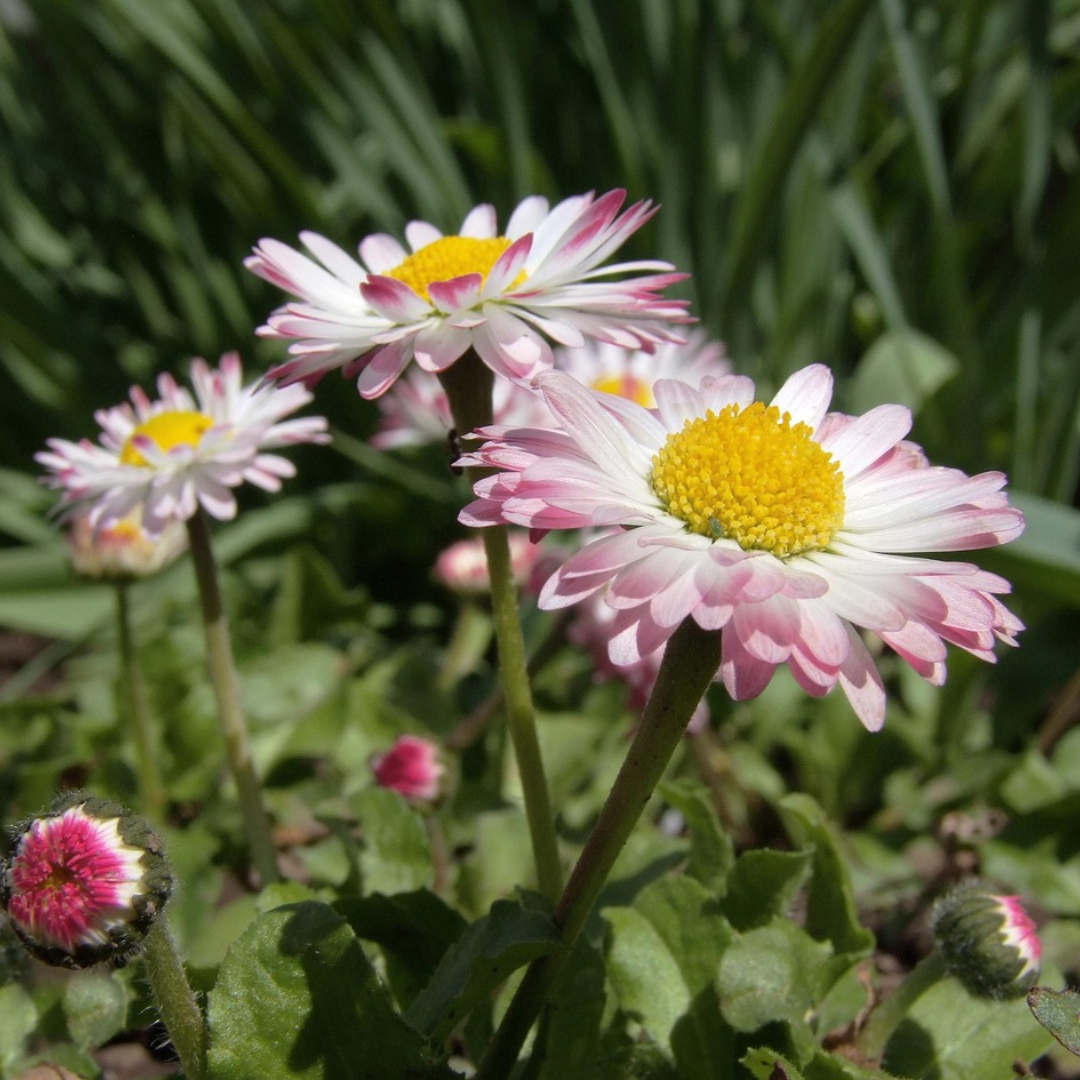
Daisies bloom all year round. // Image by Elstef on Pixabay.
Daisy (Bellis Perennis)

Daisies bloom all year round. // Image by Elstef on Pixabay.
The common daisy (Bellis perennis) belongs to the daisy family, as you can tell by its characteristic flowers. Almost everyone recognizes the blooms of the daisy, and they can be seen nearly year-round. Daisies are perennial and very hardy plants. That’s why they grow in all kinds of places: from meadows and roadsides to gardens and lawns. They’re also edible and very healthy. Learn more about the daisy and how to use it in the kitchen or as a medicinal plant here.
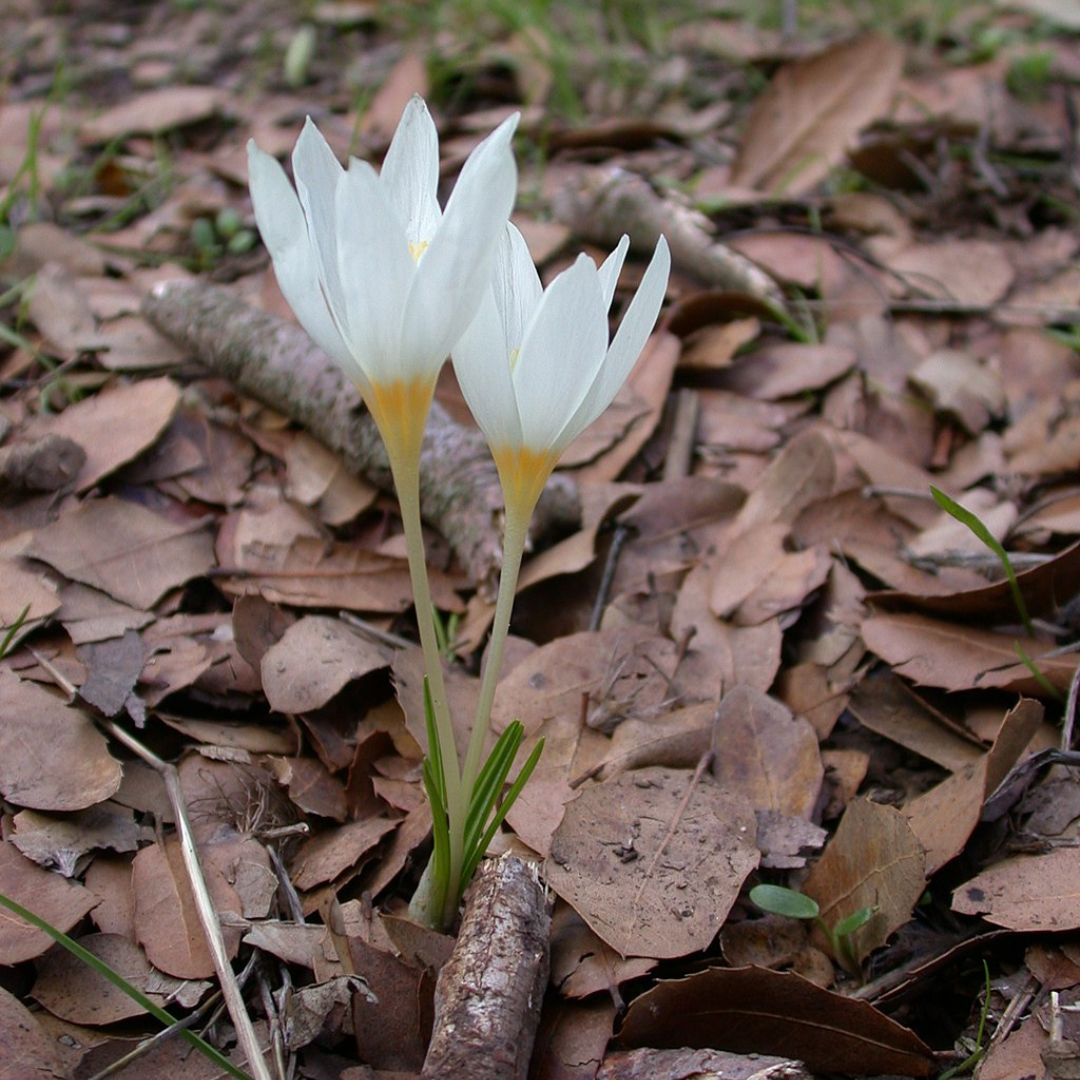
Crocuses sprout individually from the forest floor. // Image by Gideon Pisanty on Wikimedia Commons, CC BY 3.0
Crocus (Crocus L.)

Crocuses sprout individually from the forest floor. // Image by Gideon Pisanty on Wikimedia Commons, CC BY 3.0
Crocuses (Crocus L.) are a genus in the iris family and include 235 species. As early bloomers of temperate and mid-latitudes, they are widely cultivated as ornamental plants. One species, Crocus sativus, is especially important as a crop plant—it's the source of saffron. The flowers appear between February and March. The leaves remain visible until summer and then retreat underground until the next early spring. Crocuses thrive in nutrient-rich, loose loamy soil and prefer a shady spot.

Ever Feel Lost in the Garden? Connect With Others!
In the Fryd community, you’ll find friendly and helpful gardeners ready to share ideas, give advice, and celebrate wins (and failures) together. Gardening is just more fun when you’re not doing it alone.
Join the Community NowEarly Bloomers in March: Harbingers of Spring
| Early Bloomer | Flowering Time | Location | Edible |
|---|---|---|---|
| Goat willow | March - April | sunny, moist | yes, the young shoots (medicinal plant) |
| Lungwort | March - May | partially shaded, humus-rich | yes, it is used as a medicinal plant |
| Violet | March - May | partially shaded, humus-rich | yes, flowers are edible |
| Forsythia | March - May | sunny - partially shaded | yes, flowers are edible in moderation |
| Primrose | March - May | sunny - partially shaded | yes |
| Liverwort | March - May | partially shaded, calcareous | no, mildly toxic |
| Wood anemone | March - April | partially shaded, humus-rich | no, mildly toxic |
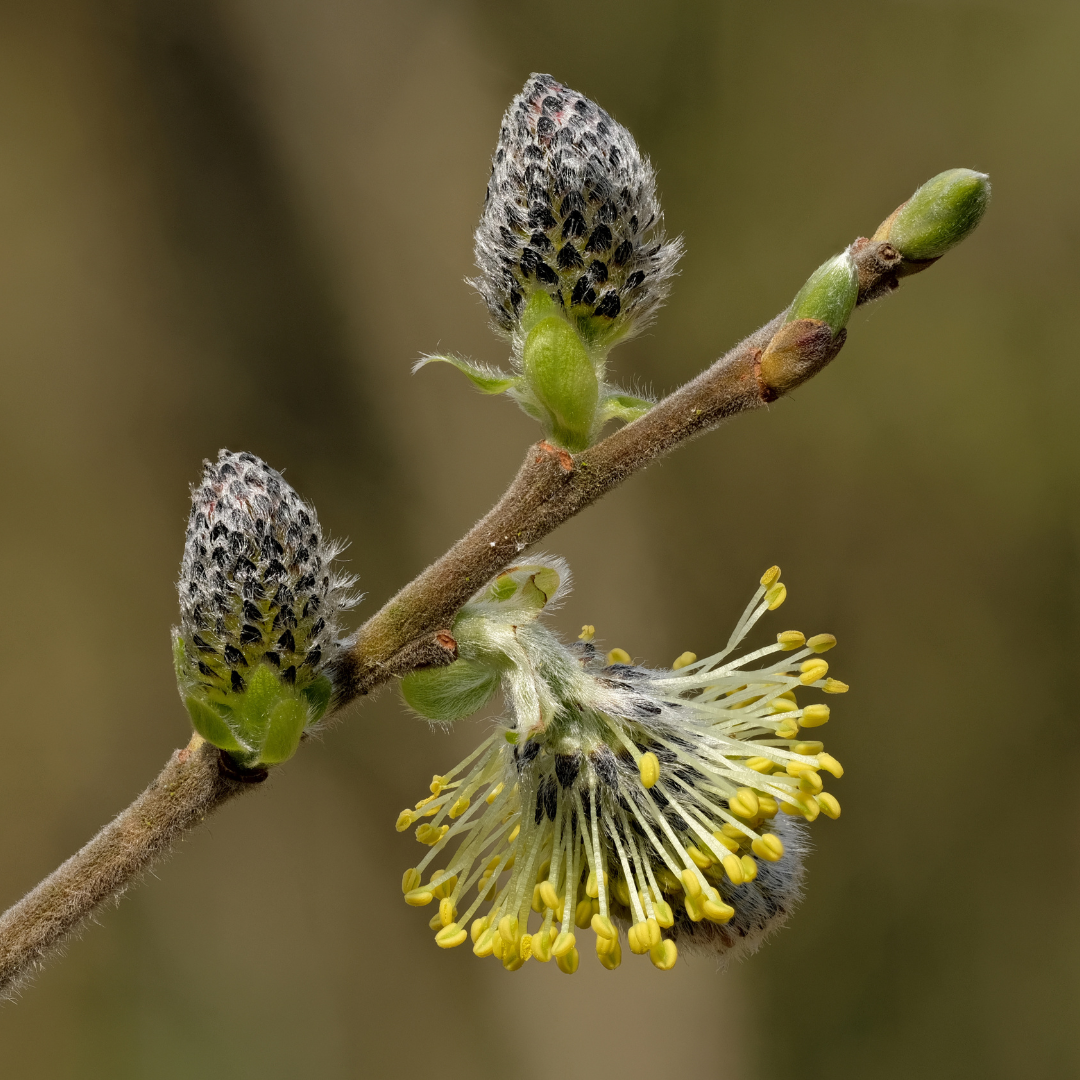
The willow catkins are a true feast for insects. // Image by Johannes Robalotoff on Wikimedia Commons, CC BY-SA 4.0
Goat Willow (Salix Caprea)

The willow catkins are a true feast for insects. // Image by Johannes Robalotoff on Wikimedia Commons, CC BY-SA 4.0
The goat willow (Salix caprea) belongs to the willow family. Thanks to its blooming period from March to April and its high pollen value, it is an important food source for insects in spring. Bees, beetles, and many species of butterflies benefit from the goat willow. It prefers sunny and moist locations. Unlike other willows, however, it is not mainly found in wet areas, but rather in open mixed forests or as a pioneer shrub on fallow land. Willow bark is also used as a medicinal remedy due to its pain-relieving, fever-reducing, and anti-inflammatory effects. Today, the active compounds of willow are used in the widely known medication aspirin.
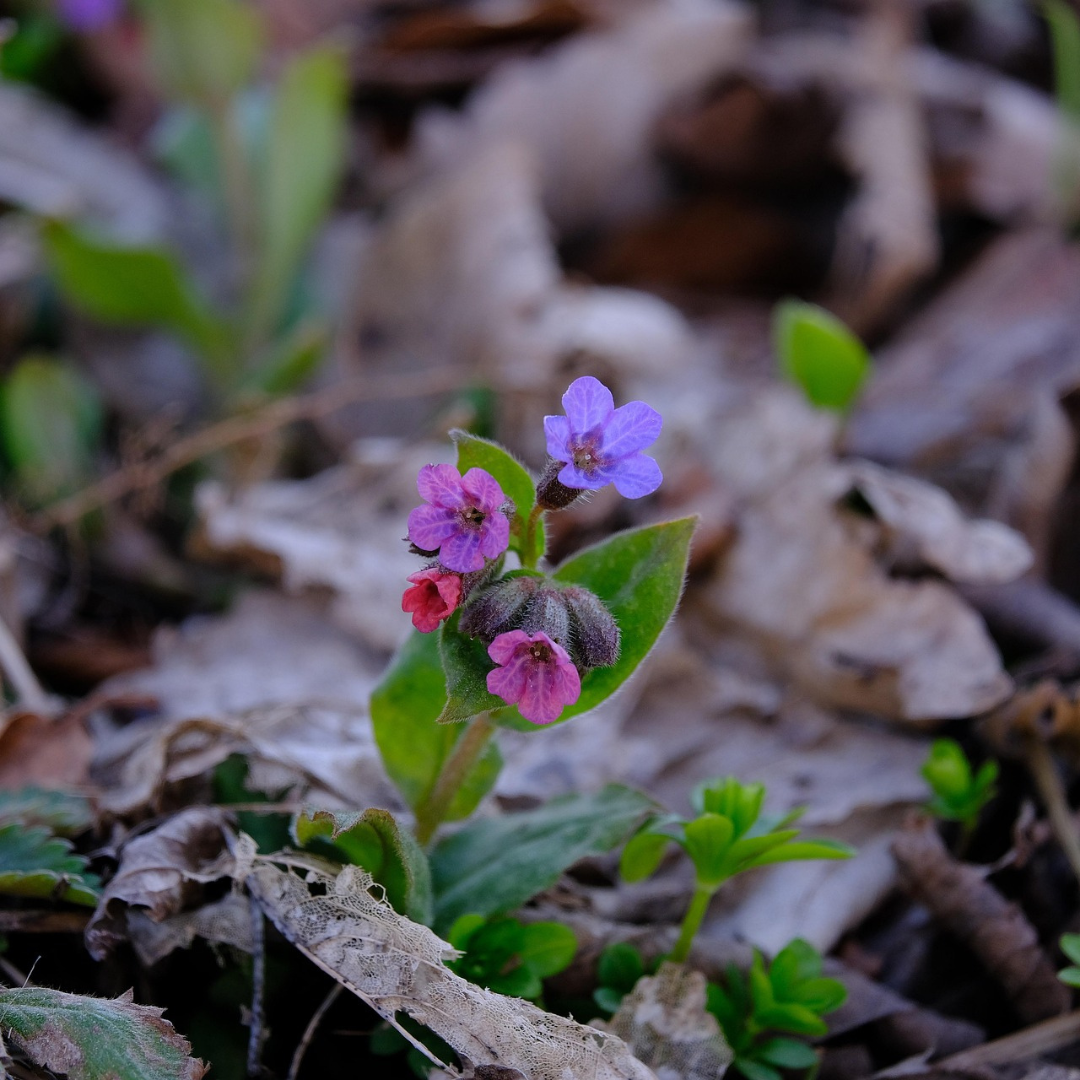
Lungwort produces beautiful pink-purple flowers. // Image by Hans on Pixabay.
Lungwort (Pulmonaria L.)

Lungwort produces beautiful pink-purple flowers. // Image by Hans on Pixabay.
Lungwort (Pulmonaria L.) is a genus within the borage family. As the name suggests, the herb was traditionally used to treat lung diseases. However, you should only use Pulmonaria officinalis, and even its leaves are edible—both raw and cooked. The flowers are also edible and appear between March and May. In Europe, lungwort is more commonly found in the north, where it grows in a variety of locations as long as there is enough moisture.
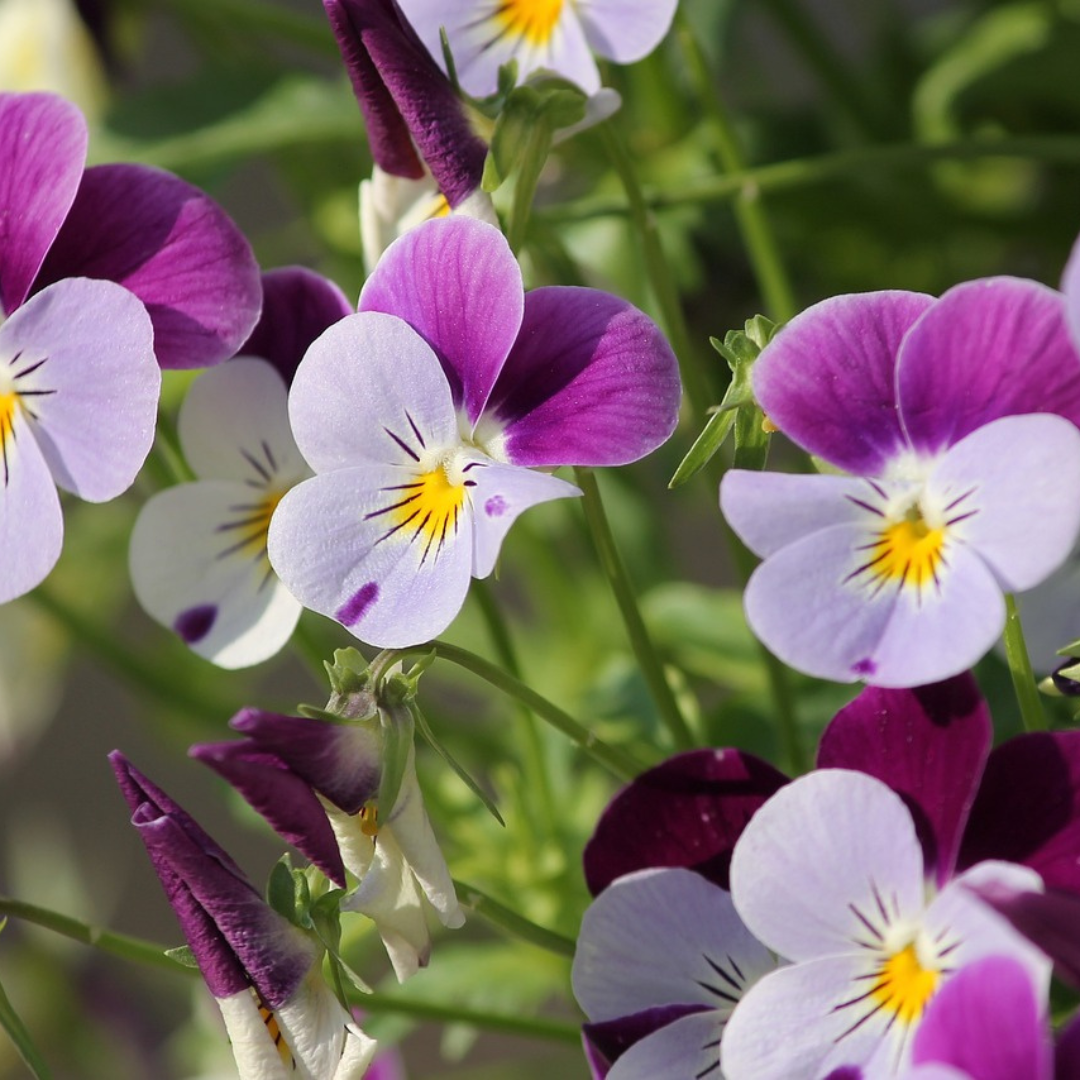
Violets are not only beautiful but also edible and healthy. // Image by Manfred Richter on Pixabay.
Violet (Viola)

Violets are not only beautiful but also edible and healthy. // Image by Manfred Richter on Pixabay.
Violets (Viola) form their own genus within the violet family, with most species thriving in our temperate zones. That’s why a moderately moist, humus-rich location—often near forests—is ideal. In hotter regions, violets are more commonly found at higher elevations. There are many different species, including early bloomers that flower from March to May. Violet blossoms are edible and considered a delicacy. You can use them to decorate salads and other dishes. But be careful: only true violets (Viola) are non-toxic. Cyclamen (also called alpine violets) can be poisonous!
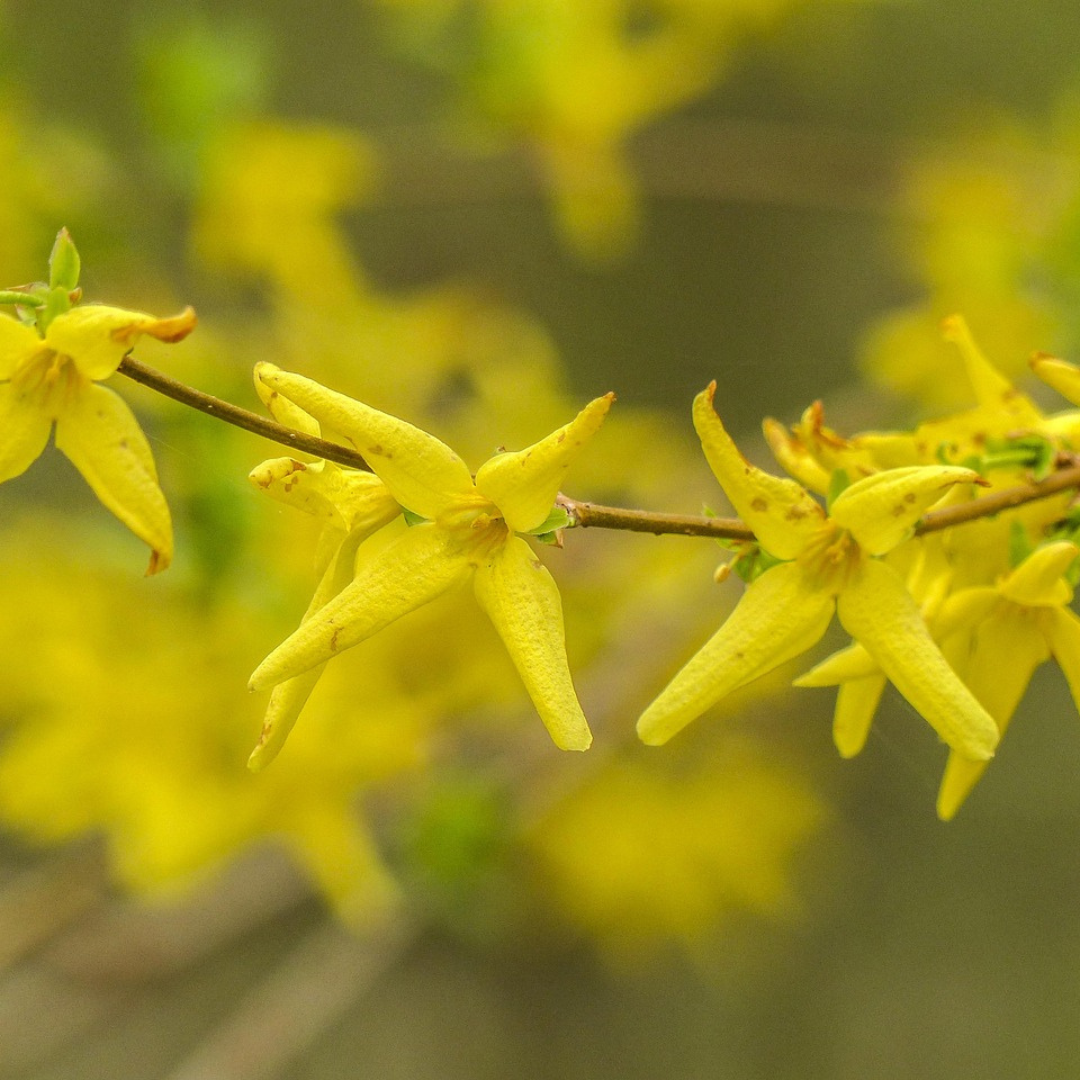
Forsythias have little ecological value. // Image by Brigitte Werner on Pixabay.
Forsythia (Forsythia)

Forsythias have little ecological value. // Image by Brigitte Werner on Pixabay.
Forsythias (Forsythia) are part of the olive family. They often have a poor reputation, as they are not native and produce sterile flowers—meaning no pollen or nectar for insects. As a result, they have little ecological value for native pollinators. Still, this plant is one of the early bloomers and welcomes spring with its bright yellow flowers. The blooming period lasts from March to May. You’ll mostly find this shrub in sunny, warm locations with humus-rich soil. The flowers are edible in small amounts, but you shouldn’t consume too many—larger quantities can cause nausea.

Primroses bloom with numerous flowers that attract insects. // Image by Pokrajac on Pixabay.
Primrose (Primula L.)

Primroses bloom with numerous flowers that attract insects. // Image by Pokrajac on Pixabay.
Primroses (Primula L.) belong to the primrose family, which is mainly found in the Northern Hemisphere. In Europe, Primula vulgaris is quite widespread. Depending on the weather, its beautiful, colorful flowers appear between March and May. You’ll mostly see primroses in gardens, meadows, forest edges, or near streams. Their blossoms attract many insects and provide a valuable food source. However, the flowers, leaves, and even the root of Primula vulgaris are also edible and have been used as a medicinal plant.
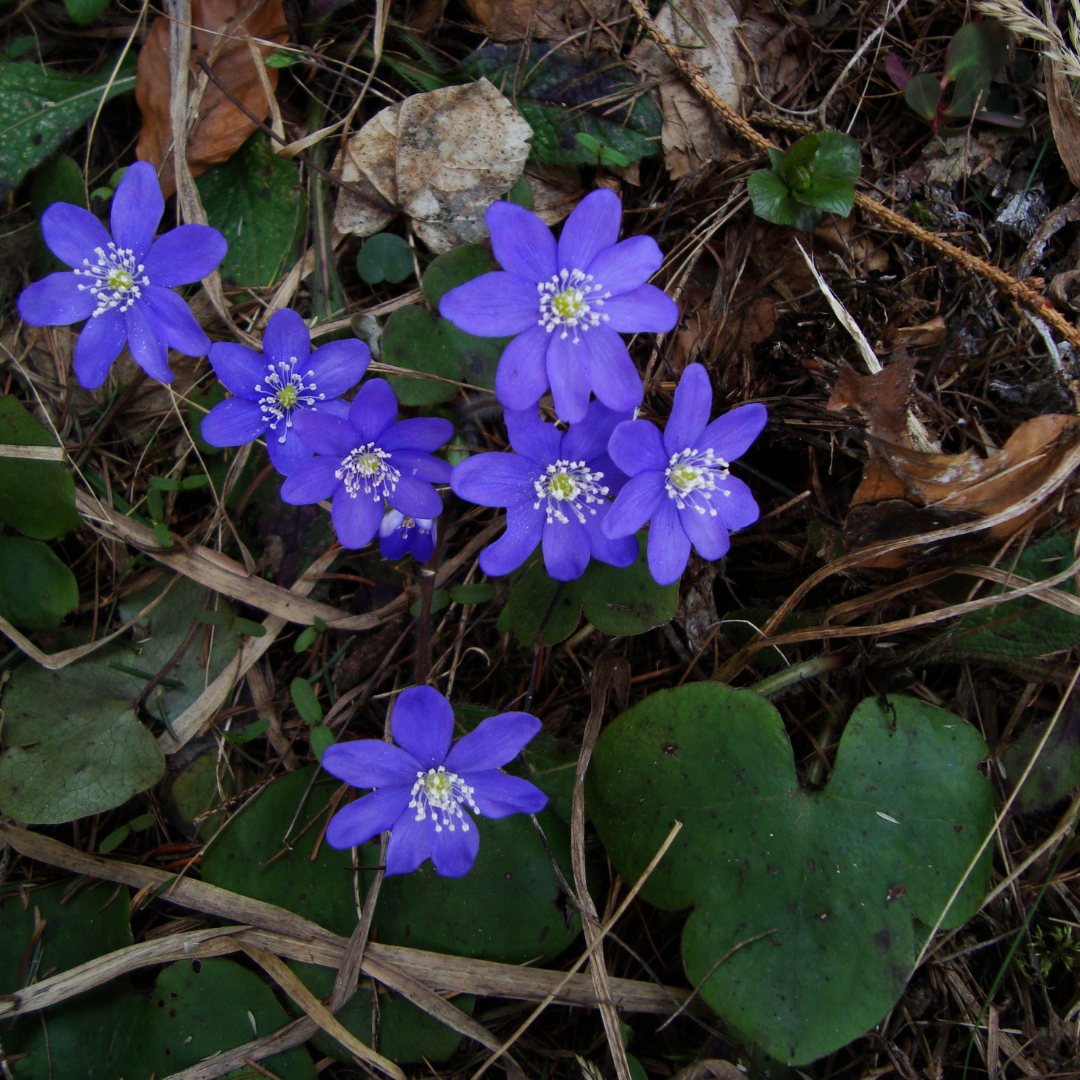
Liverworts are protected in Germany and Austria due to the loss of their natural habitat. // Image by IKAl on Wikimedia Commons, CC BY-SA 3.0
Liverwort (Hepatica Mill.)

Liverworts are protected in Germany and Austria due to the loss of their natural habitat. // Image by IKAl on Wikimedia Commons, CC BY-SA 3.0
Liverwort (Hepatica Mill.) belongs to the buttercup family. Its blue-white flowers appear between March and May. It prefers (partially) shaded locations with loamy soil. This early bloomer is also important for insects like bees and hoverflies, offering a rich supply of pollen. Please do not use this herb—it is mildly toxic. Like most buttercups, it contains the toxin protoanemonin. Historically, the plant was used as a medicinal herb, especially for liver treatments, as drying converts protoanemonin into the non-toxic compound anemonin. Additionally, liverwort is a protected species in Germany and must not be picked or dug up (NABU, 2024)!
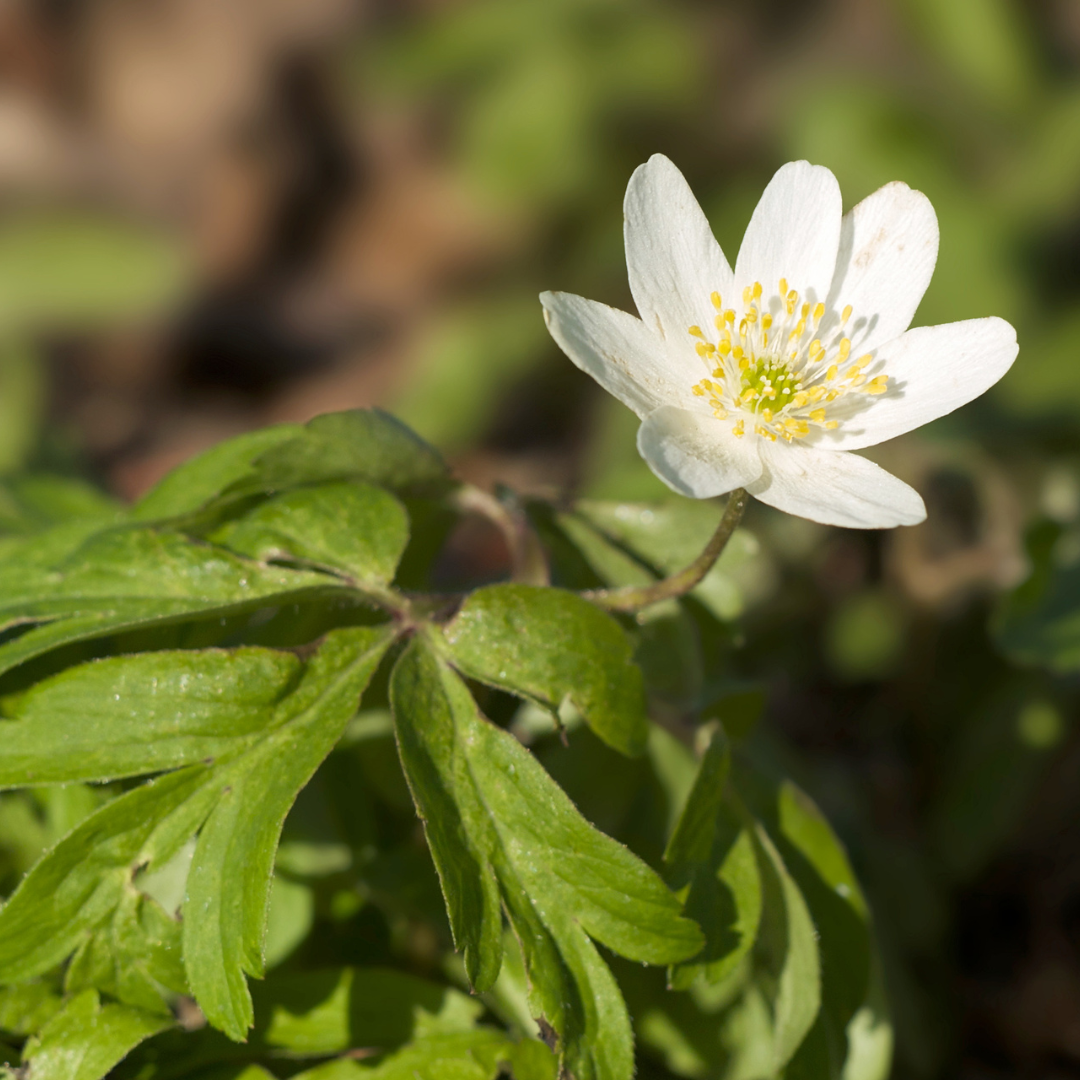
You probably know wood anemones from the forest. // Image by Jörg Hempel on Wikimedia Commons, CC BY-SA 3.0 de
Wood Anemones (Anemone Nemorosa L.)

You probably know wood anemones from the forest. // Image by Jörg Hempel on Wikimedia Commons, CC BY-SA 3.0 de
Wood anemones (Anemone nemorosa L.) form a distinct genus within the buttercup family. They love sunlight, which is why they bloom so early—taking advantage of the still open, sunlit forests. Between March and April, you can find their delicate flowers in mixed woodlands or along forest paths. Like most members of the buttercup family, all parts of the plant are toxic and should not be consumed.
Spring Is Here: Spring Flowers From April
| Early Bloomer | Flowering Time | Location | Edible |
|---|---|---|---|
| Grape hyacinth | April - May | sunny | no |
| Tulip | April - May | sunny | no |
| Wild garlic | April - May | partially shaded, humus-rich | yes |
| Blackthorn | April - May | sunny, rather dry | yes, berries and flowers are edible |
| Dandelion | April - June | partially shaded, humus-rich | yes |
| Lesser celandine | April - May | moist, shaded | yes, until they start flowering |
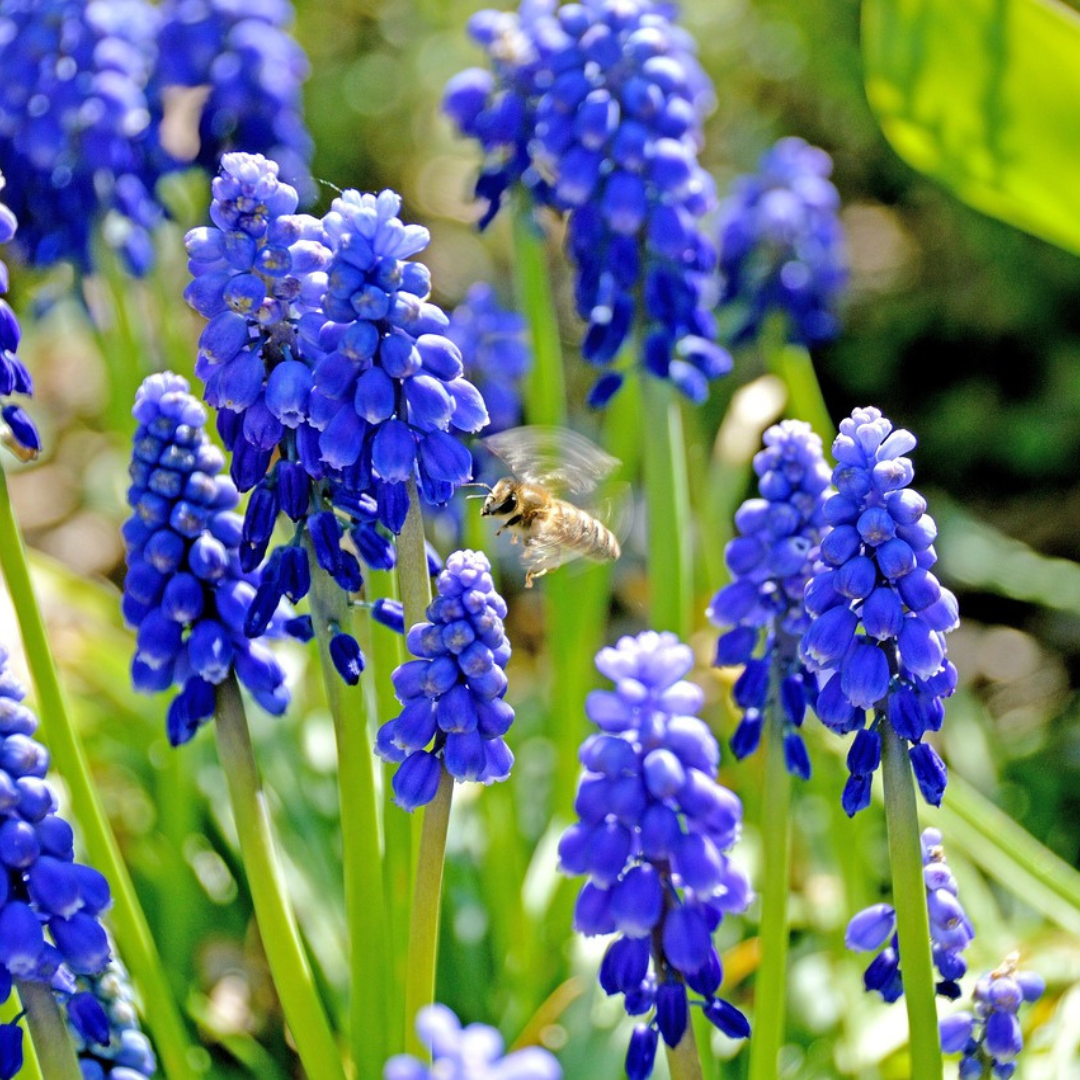
Grape hyacinths bloom between March and May. // Image by Katja Fissel on Pixabay.
Grape Hyazinth (Muscari Mill.)

Grape hyacinths bloom between March and May. // Image by Katja Fissel on Pixabay.
Grape hyacinths (Muscari Mill.) have striking blue to pinkish flowers, which is why they are often planted as ornamental garden plants. They also belong to the asparagus family and are widely distributed. Grape hyacinths prefer sunny to partially shaded locations with loose soil. Their flowers bloom from April to May. While their pollen and nectar values are not particularly high, they still offer value to native wildlife. Some native insects, such as mason bees, are adapted to their flowers. That makes them a great choice for spring gardens!
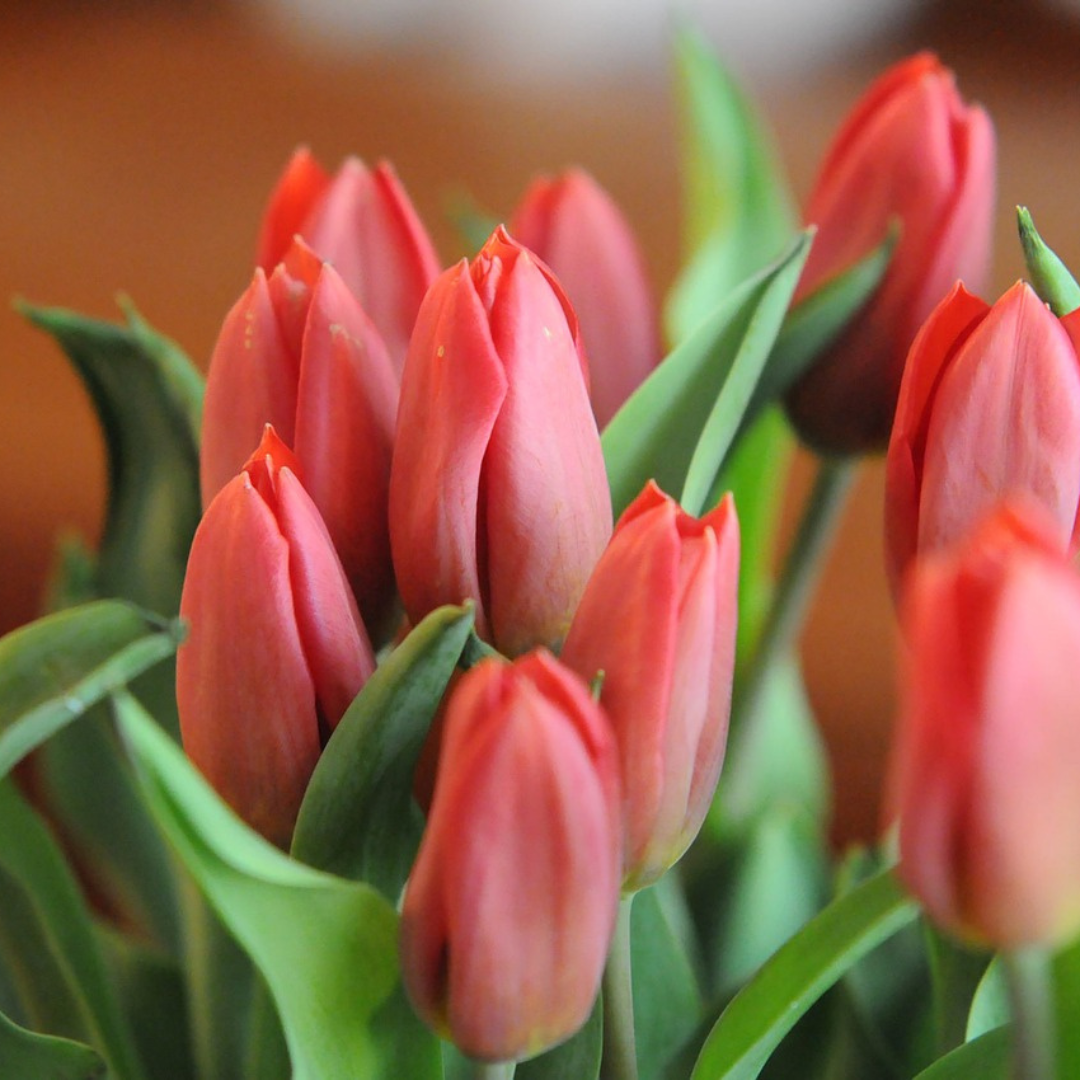
Tulips are popular ornamental flowers for spring. // Image by stanbalik on Pixabay.
Tulip (Tulipa L.)

Tulips are popular ornamental flowers for spring. // Image by stanbalik on Pixabay.
Tulips (Tulipa L.) belong to the lily family. Everyone knows them, as they are popular cut flowers. Their blooms come in all kinds of colors and appear between April and May. After flowering, the rest of the plant dies back. Tulips prefer sunny locations with slightly sandy soil. They are toxic and not edible!
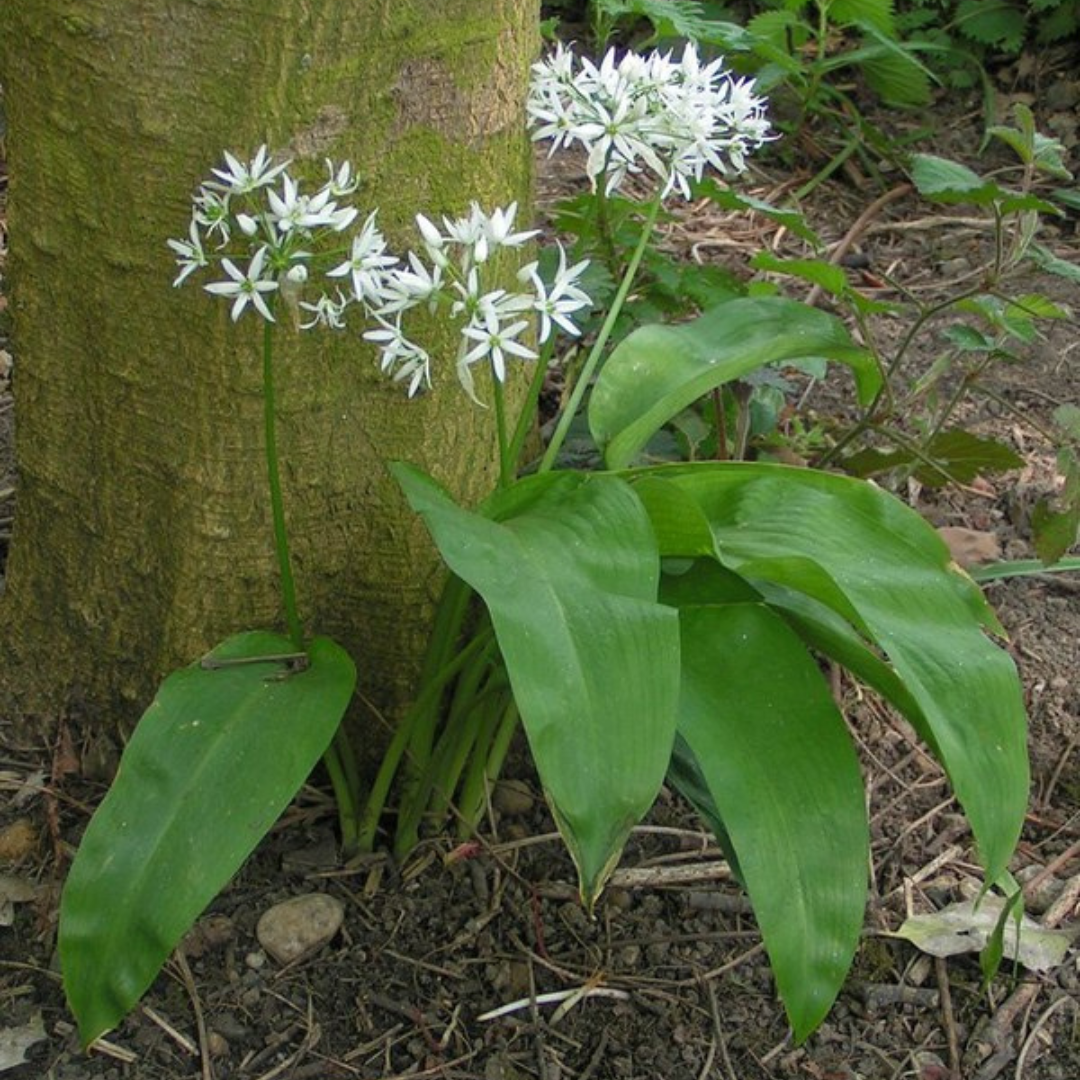
Wild garlic is delicious, with a spicy and tangy aroma. // Image by Lisa Carter on Wikimedia Commons.
Wild Garlic (Allium Ursinum)

Wild garlic is delicious, with a spicy and tangy aroma. // Image by Lisa Carter on Wikimedia Commons.
Wild garlic (Allium ursinum) is a popular wild herb often foraged in spring. It belongs to the Allium genus and is related to chives, onions, and garlic. Its white flowers appear between April and May. It's best to harvest the leaves before flowering, as they are more aromatic then—but the flowers are also edible. However, always leave enough behind in the forest (rule of thumb: no more than 5% of the population). Wild garlic prefers (partially) shaded, moist locations, often in forests or near bodies of water. This plant is also popular with bees and other insects, as it provides pollen and nectar early in the year.
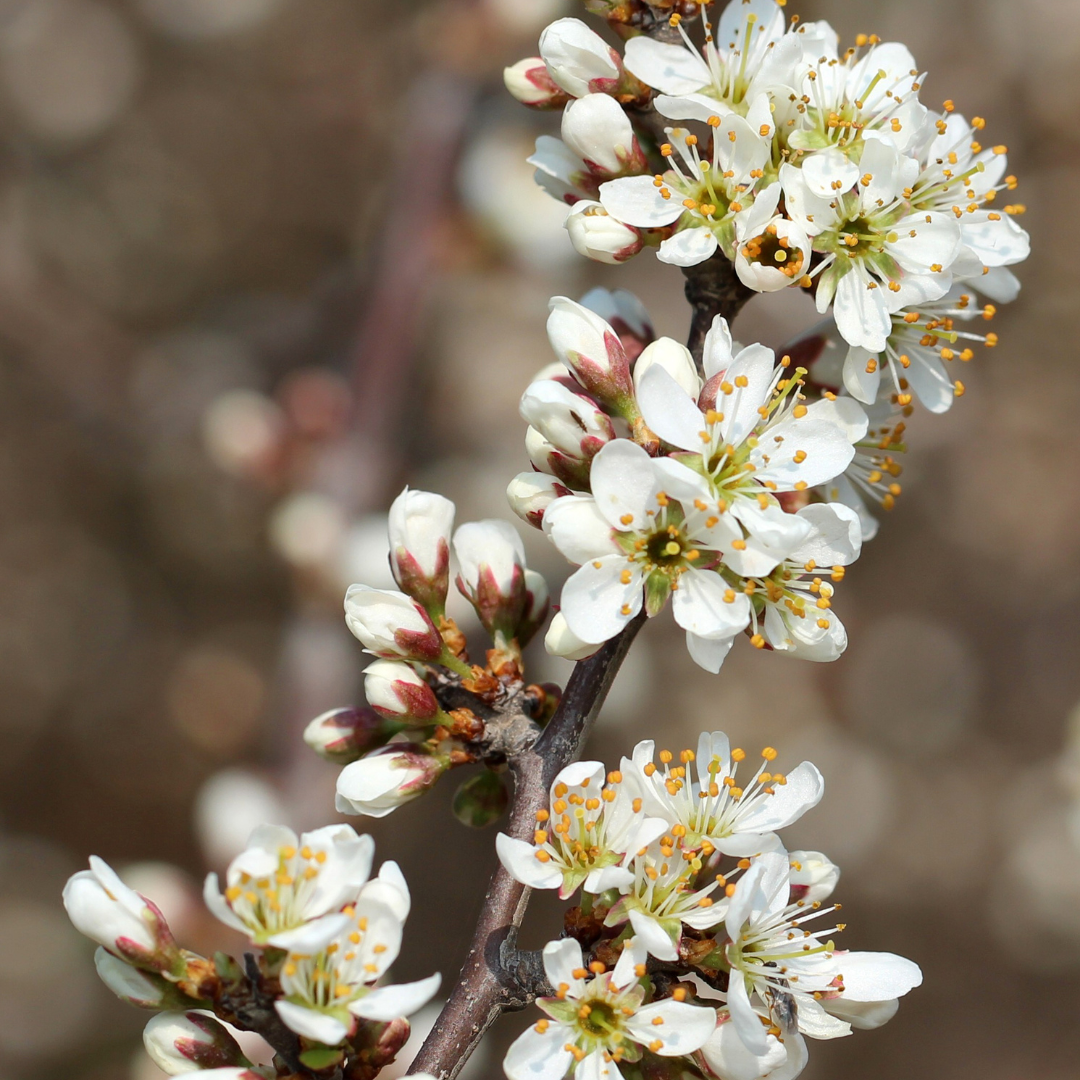
Sloe blossoms are a true haven for bees. // Image by Smartbyte on Wikimedia Commons, CC BY-SA 3.0
Blackthorn (Prunus Spinosa)

Sloe blossoms are a true haven for bees. // Image by Smartbyte on Wikimedia Commons, CC BY-SA 3.0
Sloe or blackthorn (Prunus spinosa) is actually part of the rose family. Its characteristic white blossoms usually appear from April to May. You’ll often find it growing on former fallow land, in open woodlands, or in hedgerows. The soil should be well-drained, and even dry spells don’t bother this shrub. Sloe is an important source of nectar and pollen for bees in spring—you can spot many different insects around it, including some rare native wild bee species. The fruits are often used (without the pit!), but the blossoms can also be made into tea. However, don’t use too much—both the leaves and flowers can have a mild laxative effect.
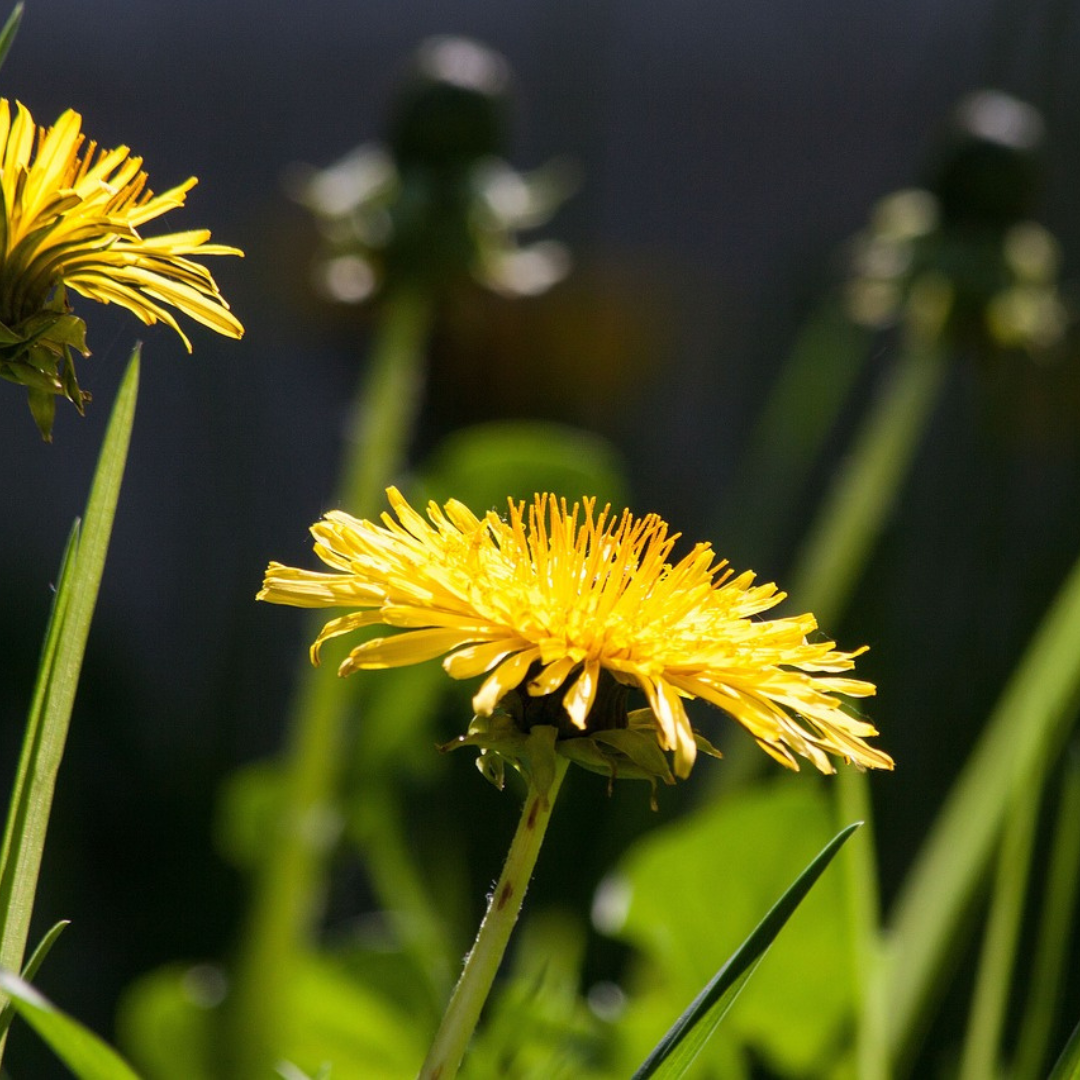
Dandelions begin to bloom with their bright yellow flowers in March. // Image by Stefan Schweihofer on Pixabay.
Dandelion (Taraxacum)

Dandelions begin to bloom with their bright yellow flowers in March. // Image by Stefan Schweihofer on Pixabay.
Dandelion (Taraxacum) belongs to the daisy family. This plant is found all over the world, but is especially common in temperate regions. It prefers sunny to partially shaded spots with humus-rich soil. The yellow flowers bloom from April to June. Dandelion is a healthy wild herb rich in bitter compounds. All parts of the plant are edible, and you can use the flowers and leaves either fresh or dried.
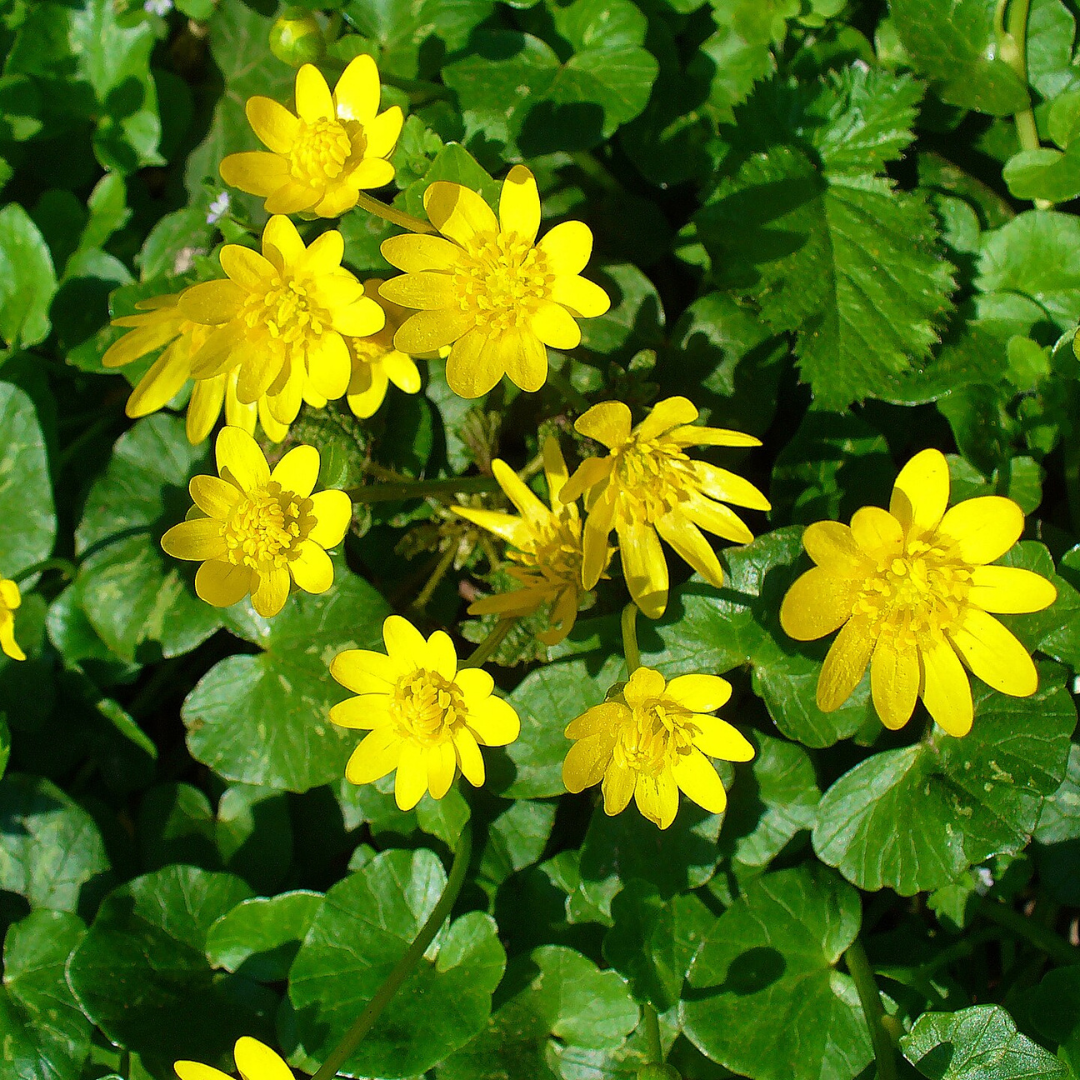
Lesser celandine is rich in vitamin C! // Image by H. Zell on Wikimedia Commons, CC BY-SA 3.0
Lesser Celandine (Ficaria Verna)

Lesser celandine is rich in vitamin C! // Image by H. Zell on Wikimedia Commons, CC BY-SA 3.0
Lesser celandine (Ficaria verna) belongs to the buttercup family. This low-growing plant is found in moist, shady locations. The leaves of lesser celandine are edible and rich in vitamin C. However, after flowering, the plant develops a toxin typical for buttercup species and should no longer be consumed! The flowers appear from April to May and also provide food for insects.
Learn more here about how to forage and use lesser celandine.
Want to get helpful gardening tips all year round and plan your own beds in the best possible way? Then register here or download the Fryd app for Android or iOS.
Fryd - your digital bed planner
Sources:
- DWD (German Weather Service), 2023: Phenology in climate change - Part 1: Shift in the phenological seasons
- Federal Environment Agency, 2024: Changes in the seasonal development phases of plants
- Lang, W., Zhang, Y., Li, X. et al., 2025: Phenological divergence between plants and animals under climate change. Nat Ecol Evol 9, 261–272 (2025). https://doi.org/10.1038/s41559-024-02597-0
Cover image by Couleur on Pixabay.

Marie
Marie is an agronomist. She is particularly interested in the sustainable and organic cultivation of vegetables and other plants. In her own garden, she gained experience and likes to try things out to learn from nature. She is particularly interested in the values and principles of permaculture, in order to contribute not only to the well-being of nature, but also to the well-being of people and future generations.
Learn MoreCurrent Topics in the Community
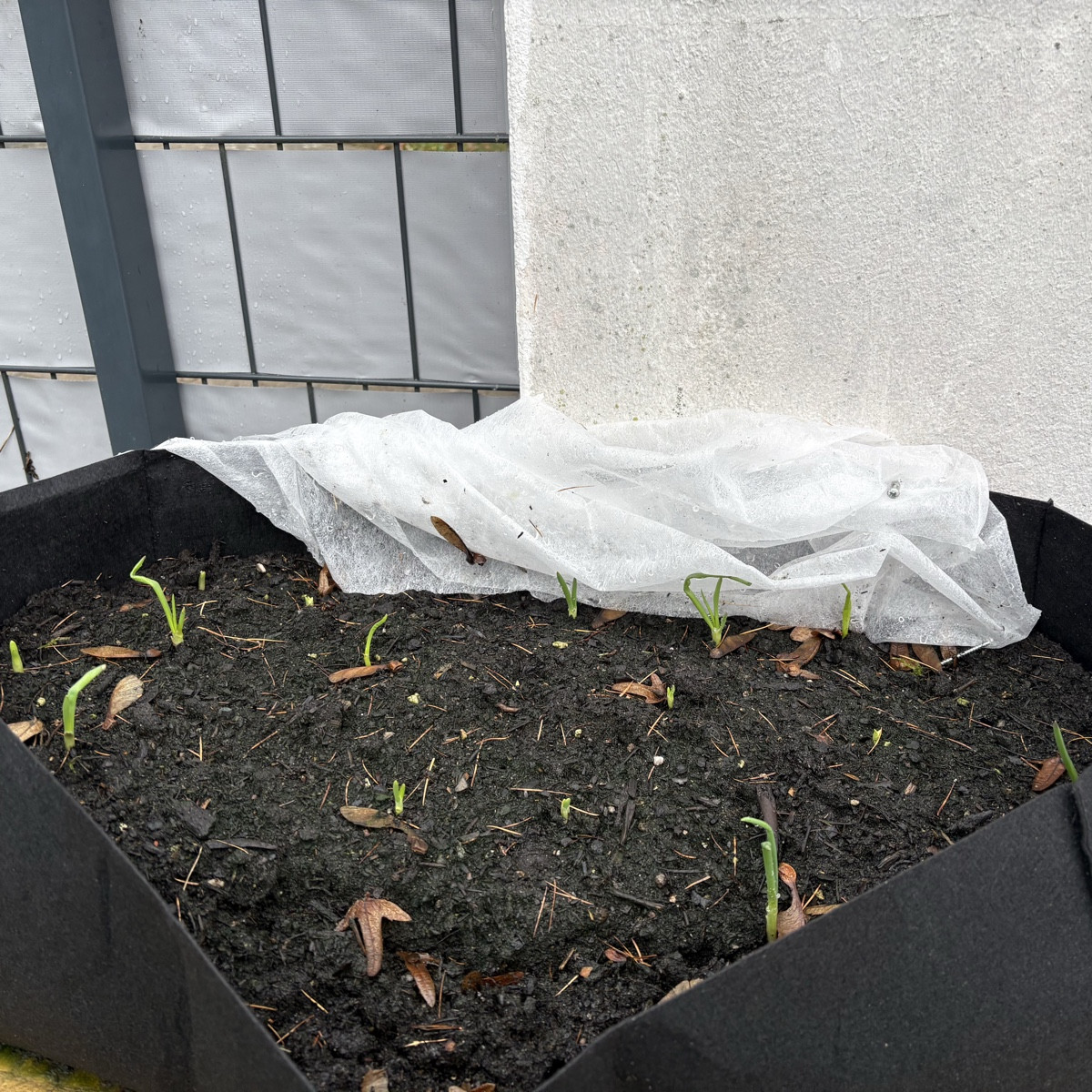
My winter onions are also growing quite well. They are of the Red Cross variety. I planted them on 28.10 in a felt pot 60x30x20 cm
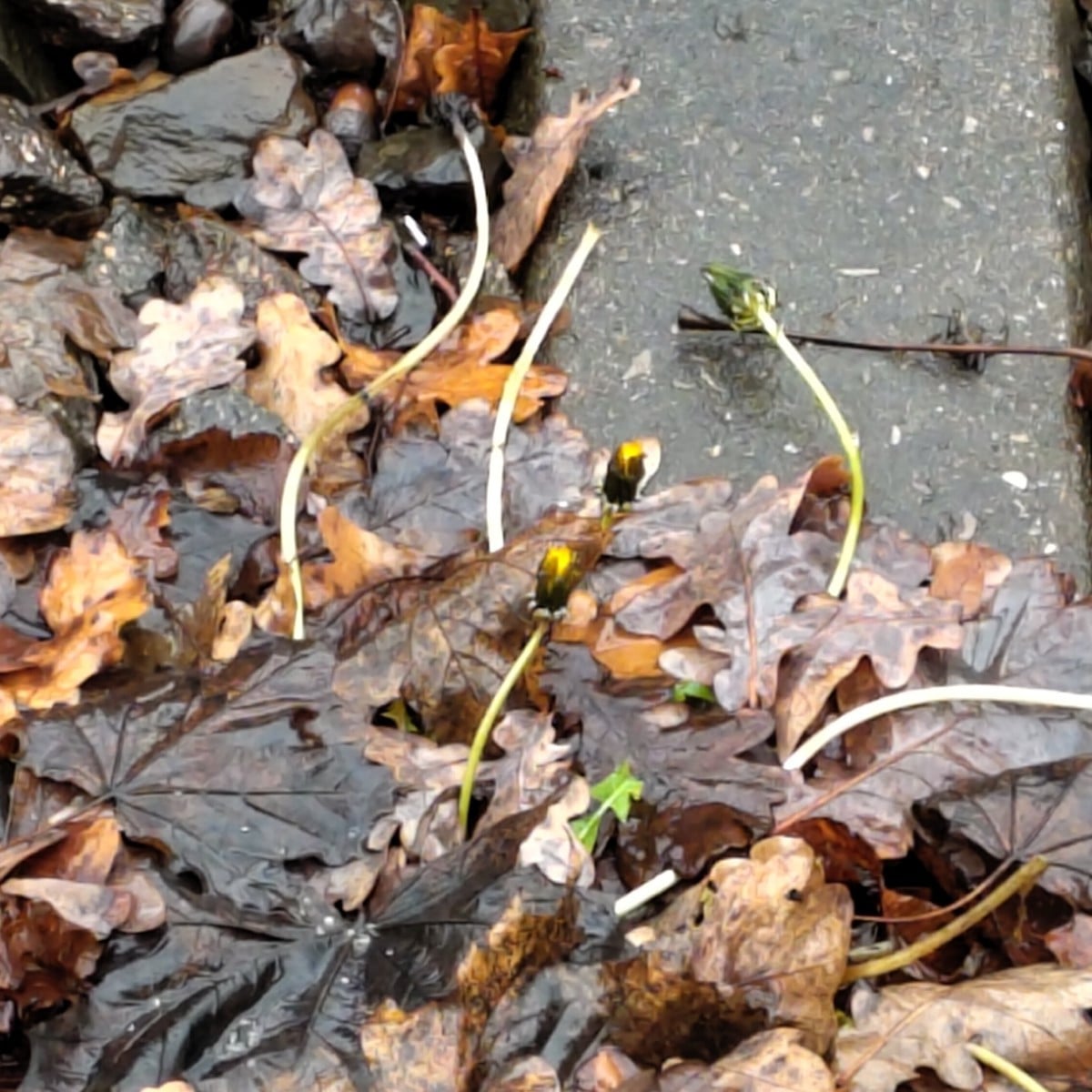
Liked 4 times
Another post from the curiosities section: I noticed this dandelion at the streetcar stop in a 'wintry' 13°C weather. It obviously thinks that snow and double-digit frost were enough winter and is now pushing new flowers through the foliage. It's a shame it's by the tracks, otherwise it would probably have ended up in my salad. 😋
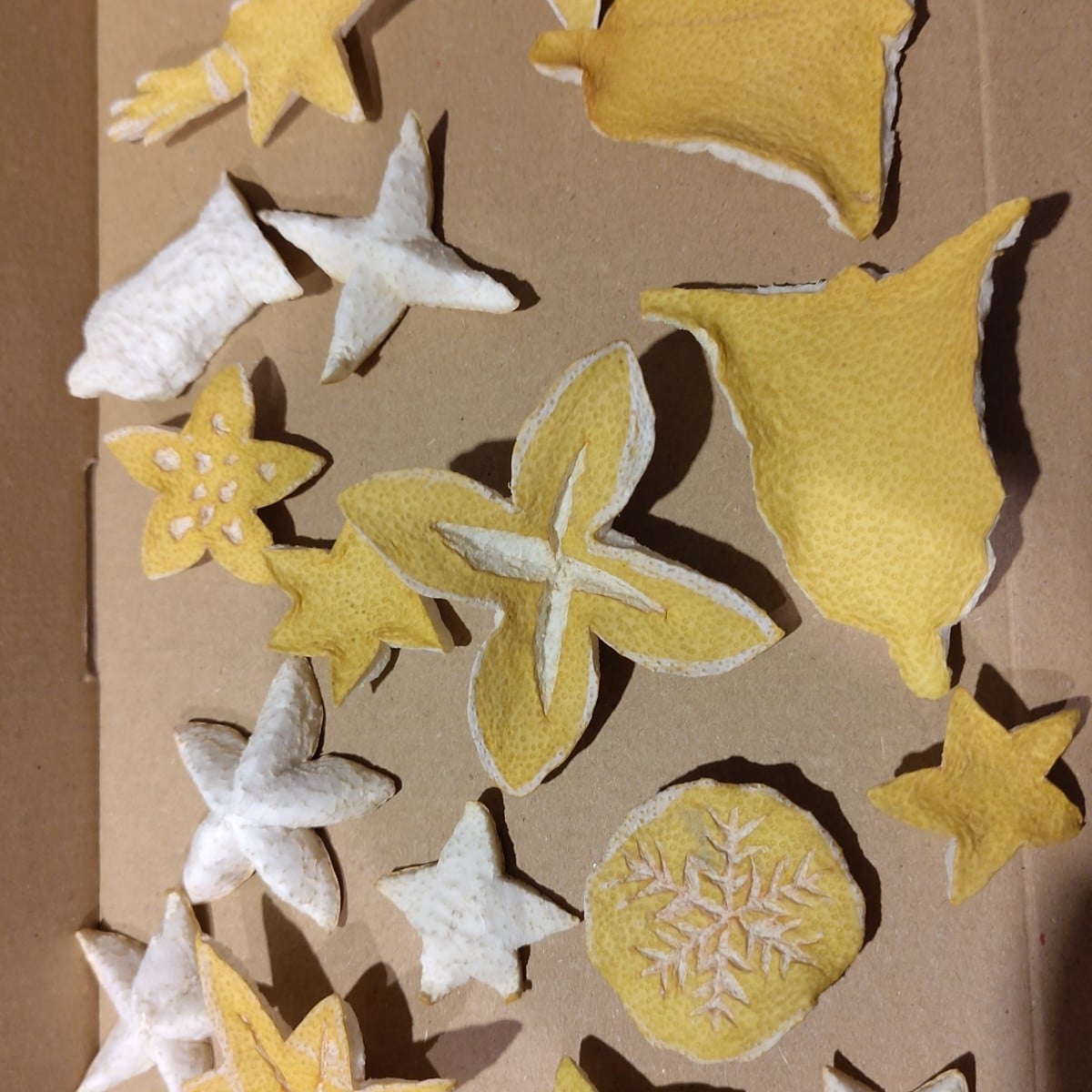
Liked 15 times
As a suggestion for those who eat citrus fruits and have some time in the evening: simply cut a few simple shapes out of them with a sharp knife and dry them on the heater. The next day it was bone dry in our house ;)
Show 3 answersPopular Articles
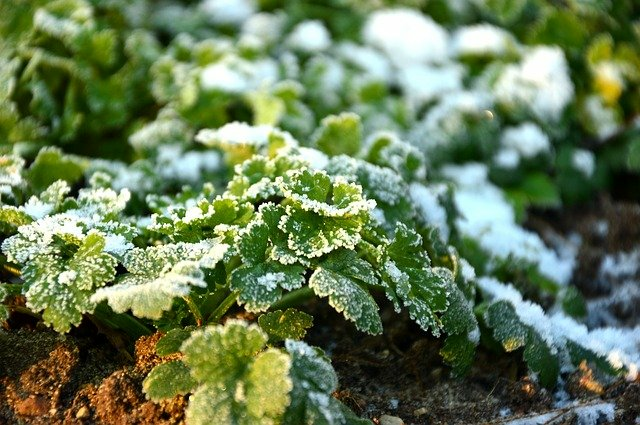
Overwintering Parsley: How to Do It Successfully
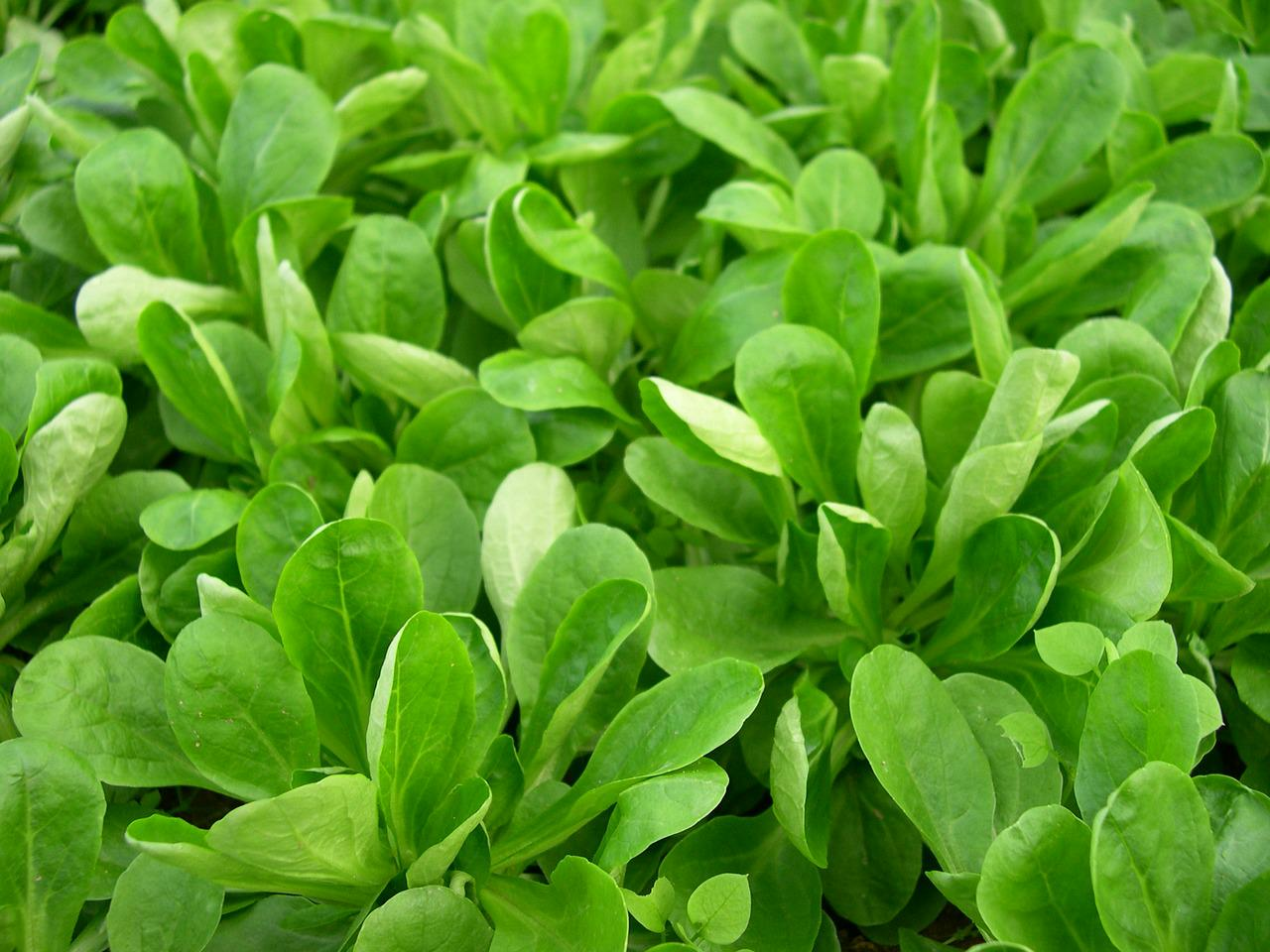
How to Grow Lettuce in Winter: Varieties, Sowing, Harvesting

Growing Sage Plant: Tips for Sowing and Harvesting
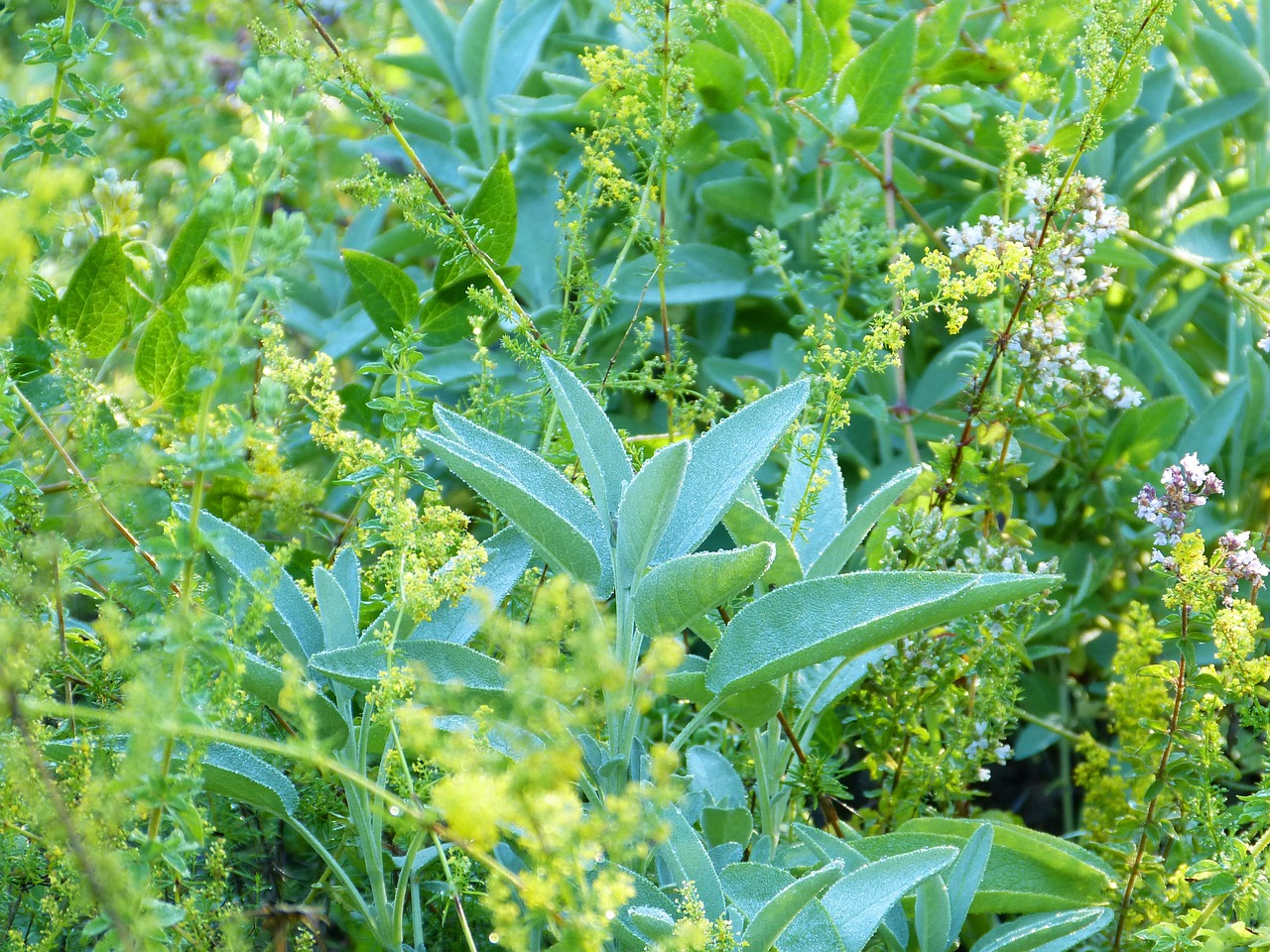
What Herbs Can Be Planted Together?
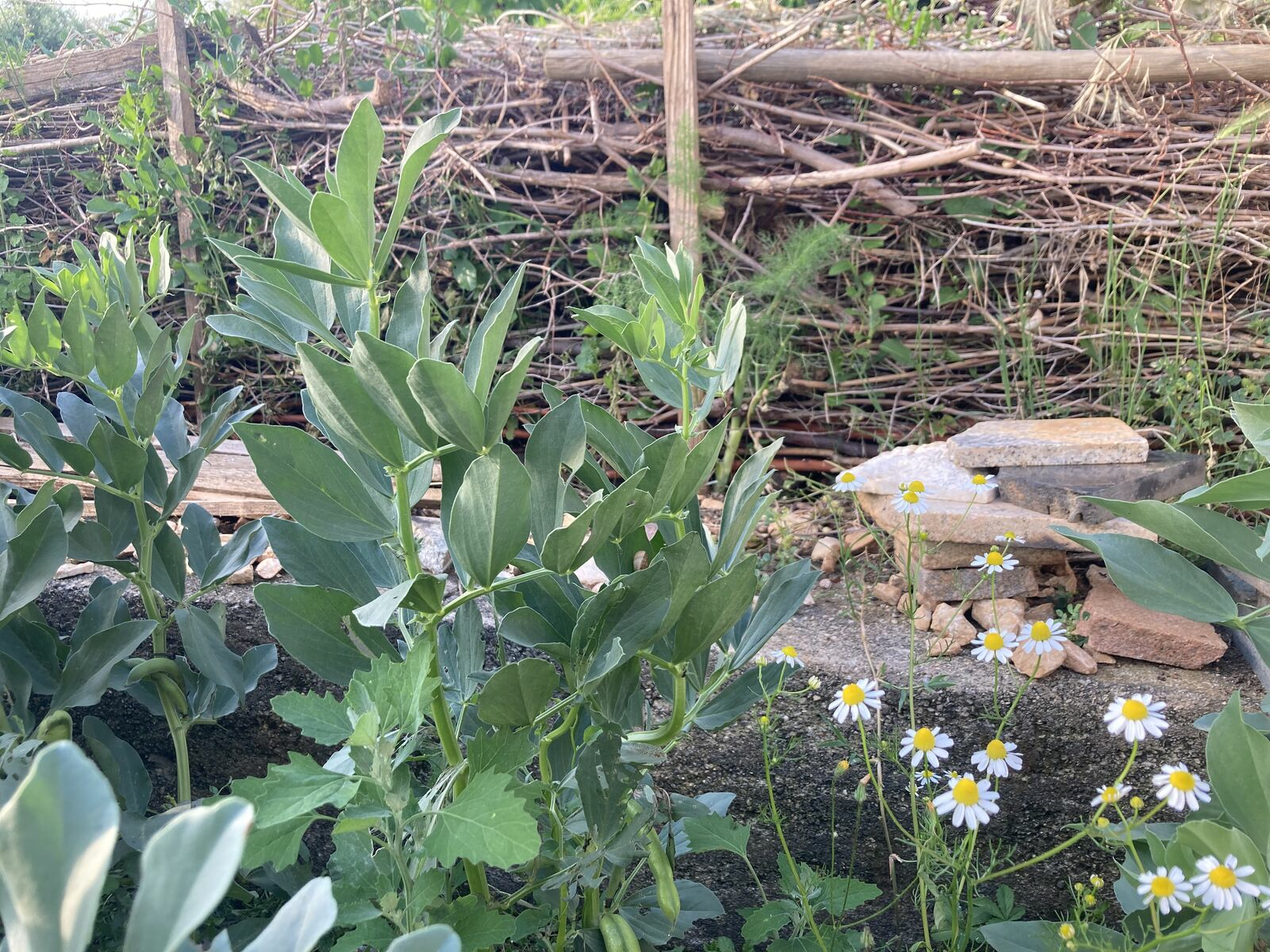
Create & Design a Permaculture Garden
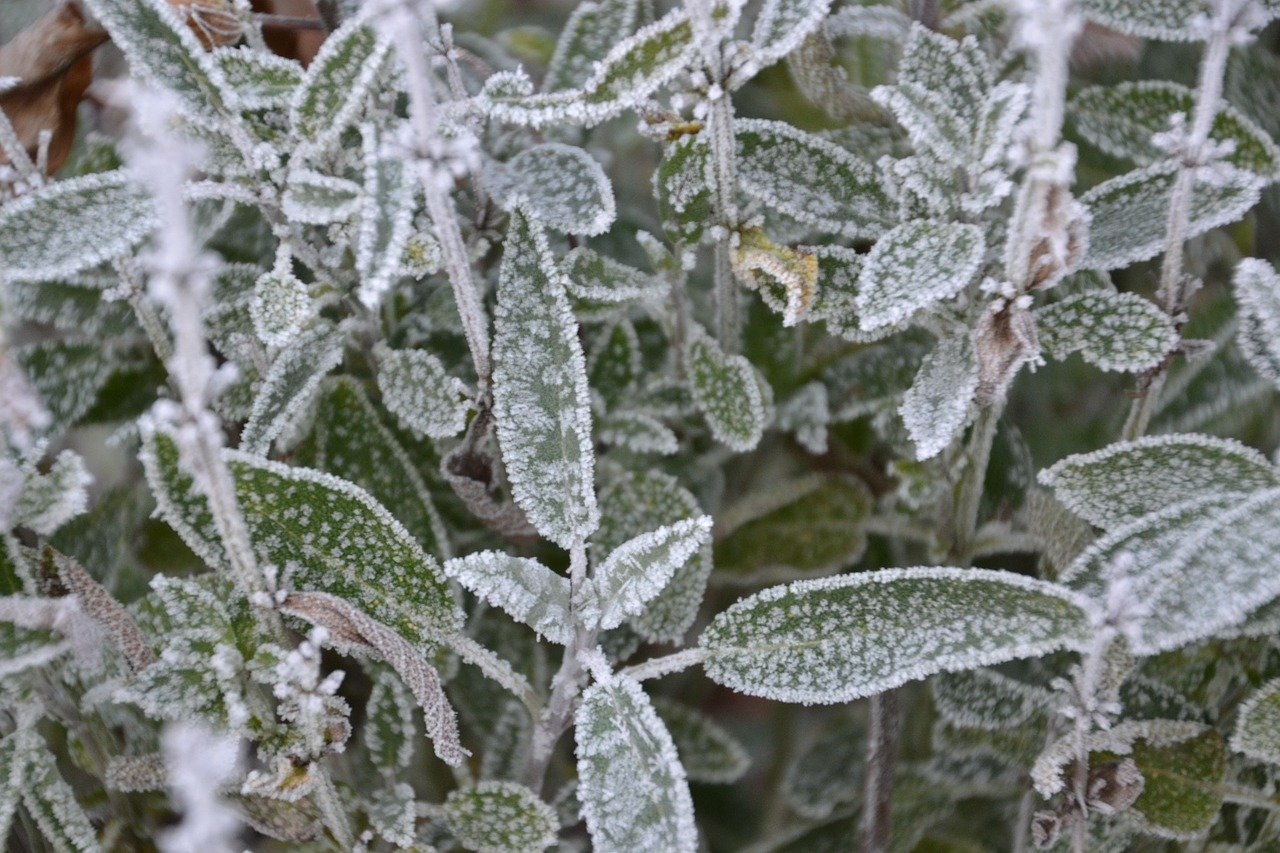
Overwintering Plants: Tubs, Pots and Raised Beds

Pruning, Fertilizing & Propagating Currants: Care Tips
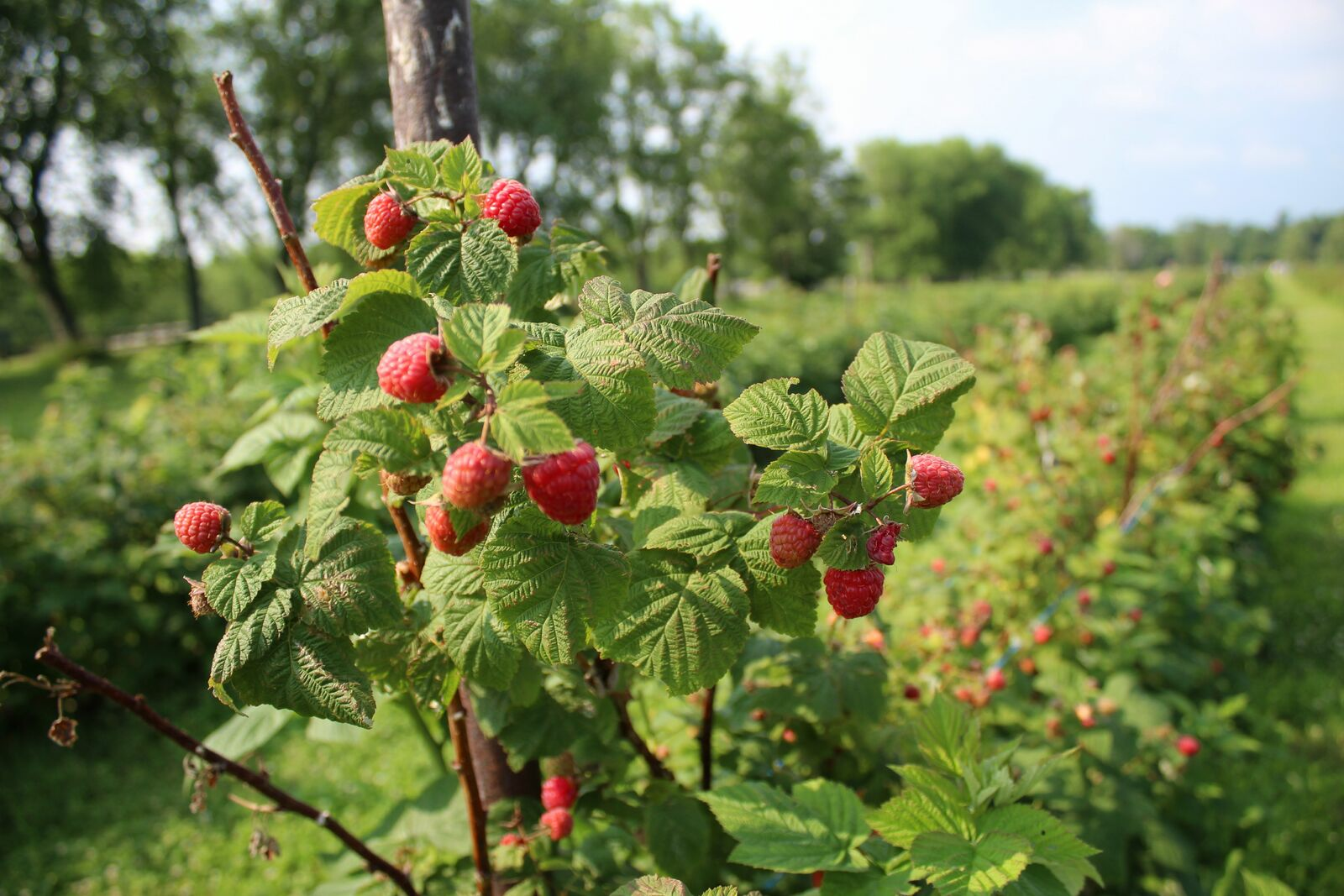
Pruning Raspberries: How to Do It
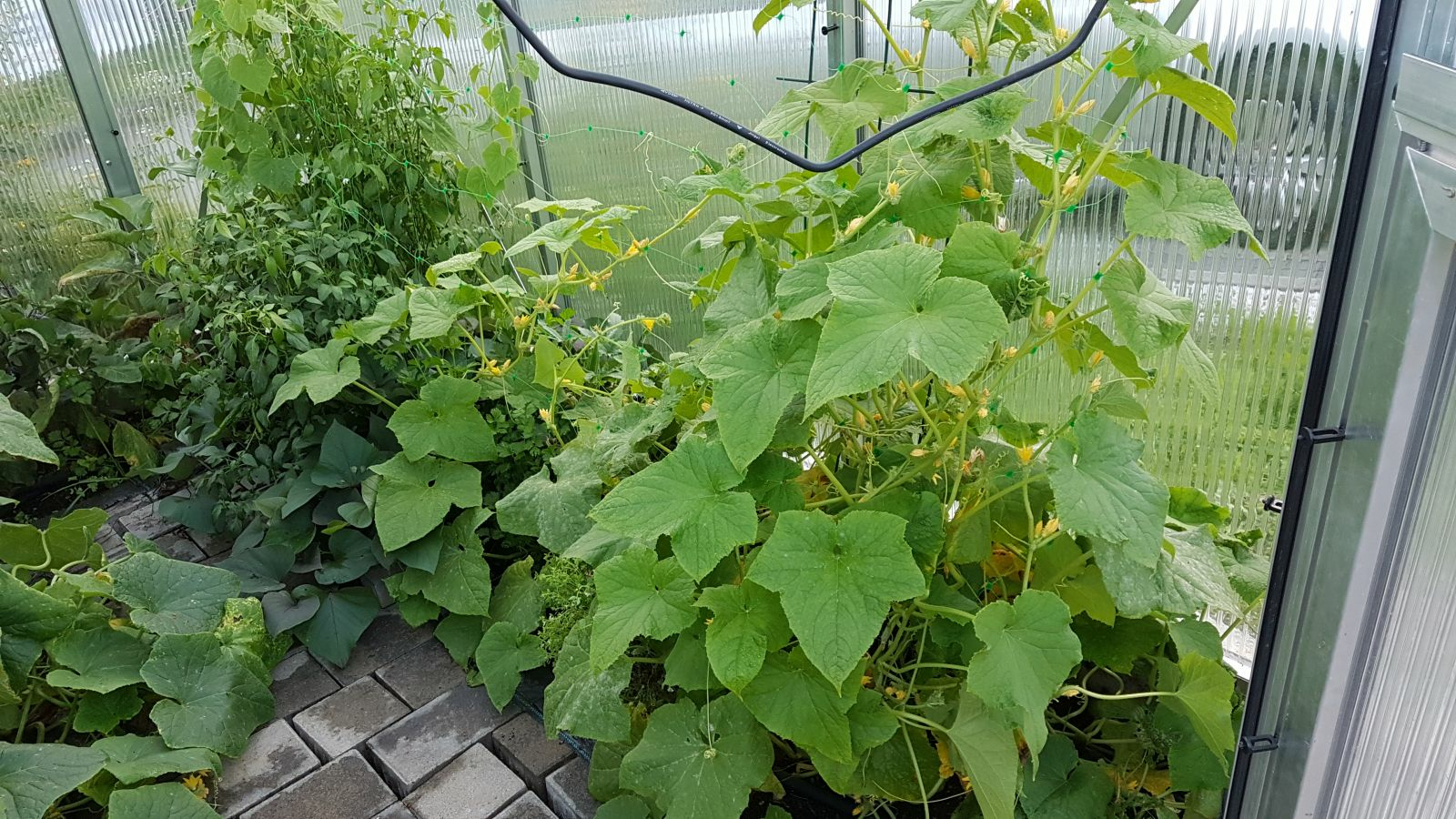
Vegetable Garden With Greenhouse: How to Use Greenhouse Effect
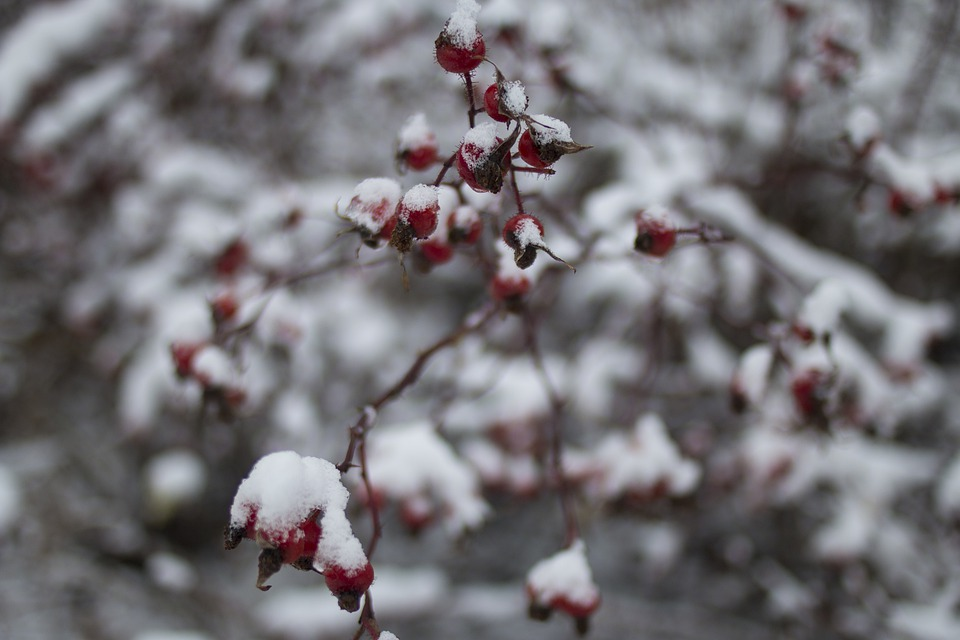
Winterizing Beds and the Garden: How to Do It
FAQ
Early bloomers are plants that show their flowers in early spring, sometimes from February - often before the leaves of the trees emerge.
Why are early bloomers important for bees and other insects?
They provide one of the first food sources of the year, helping insects to get the season off to a good start.
Which early bloomers are particularly suitable for the garden?
Popular species include snowdrops, winter aconites, crocuses, spring snowdrops and bluebells.